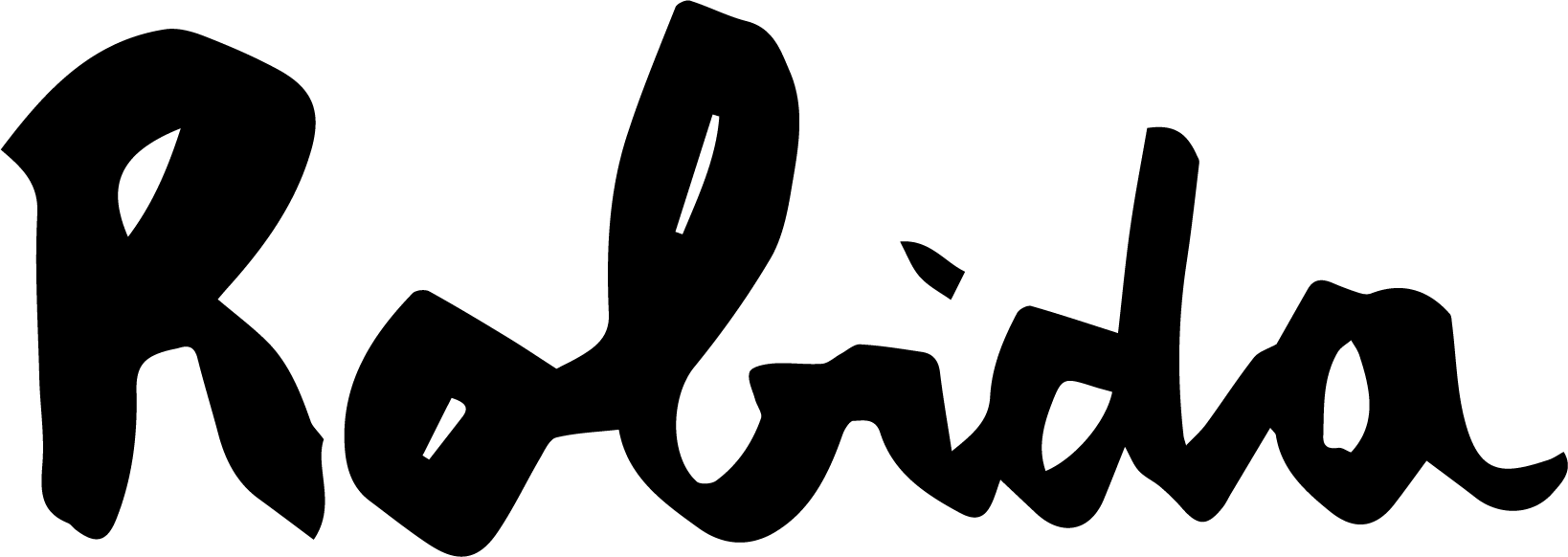Here is a sign, a trace, a mark, a dot, a line, a leftover, an image, a small something, an anecdote told by someone, an encounter, a moment, a word, un modo di dire – common saying, a note, a dog-eared page, a feeling, a question. Here is and will be a collection of lines, of stories, of passing of things: caring – carrying – maintaining.
15/12/25
_Footsteps
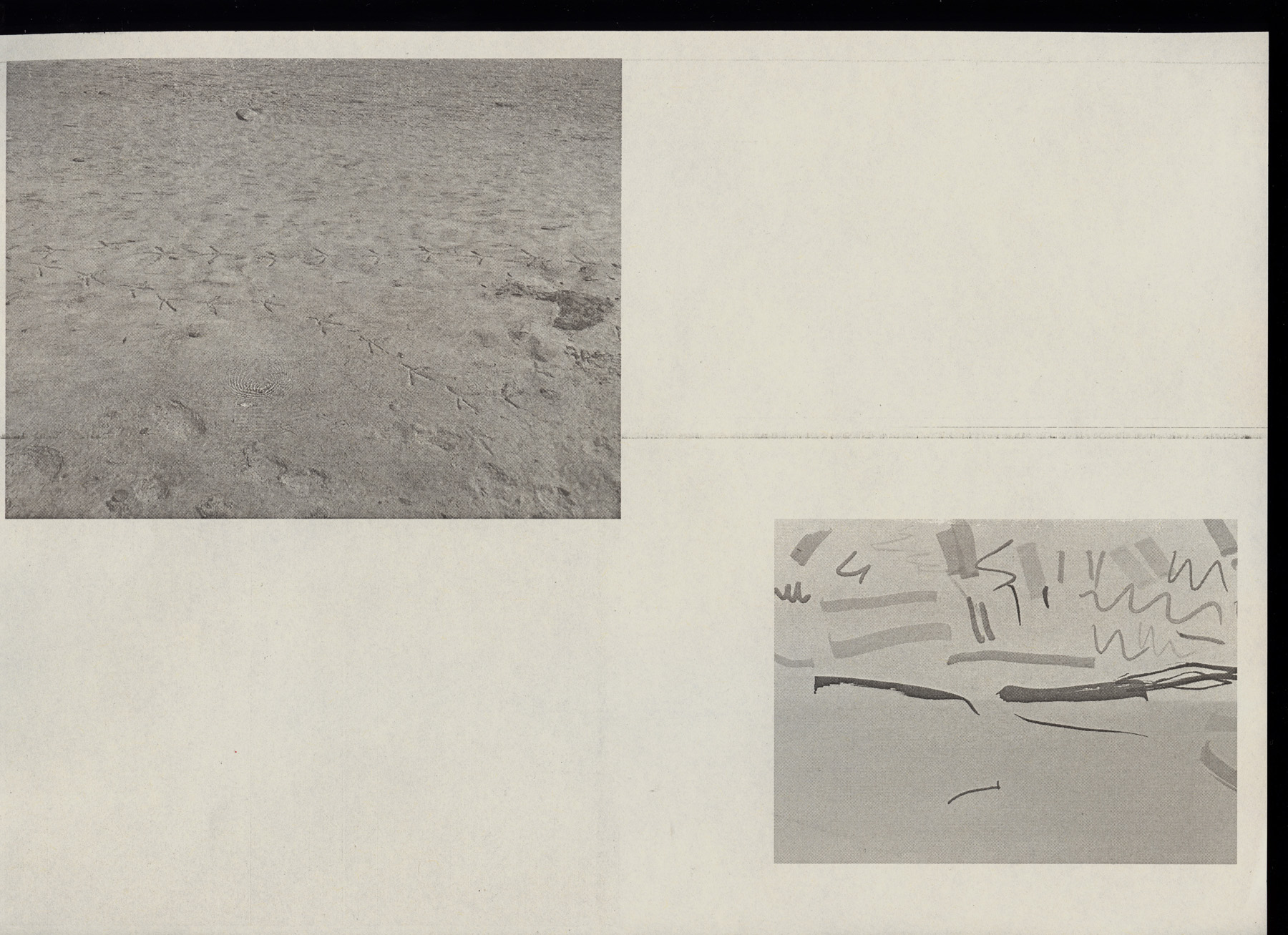
09/12/25
_Mattino
I saw a man walking in the little village of San Piero with the hands in the pockets of his pants. He moved his steps slowly down the stairs while enjoying the morning sun.
06/11/25
_Underfoot
During autumn days in the lowlands I loved the sound of dry leaves underfoot. Every time I would leave or arrive to her place I would walk through and around them.
11/10/25
_Some Summer's Correspondences
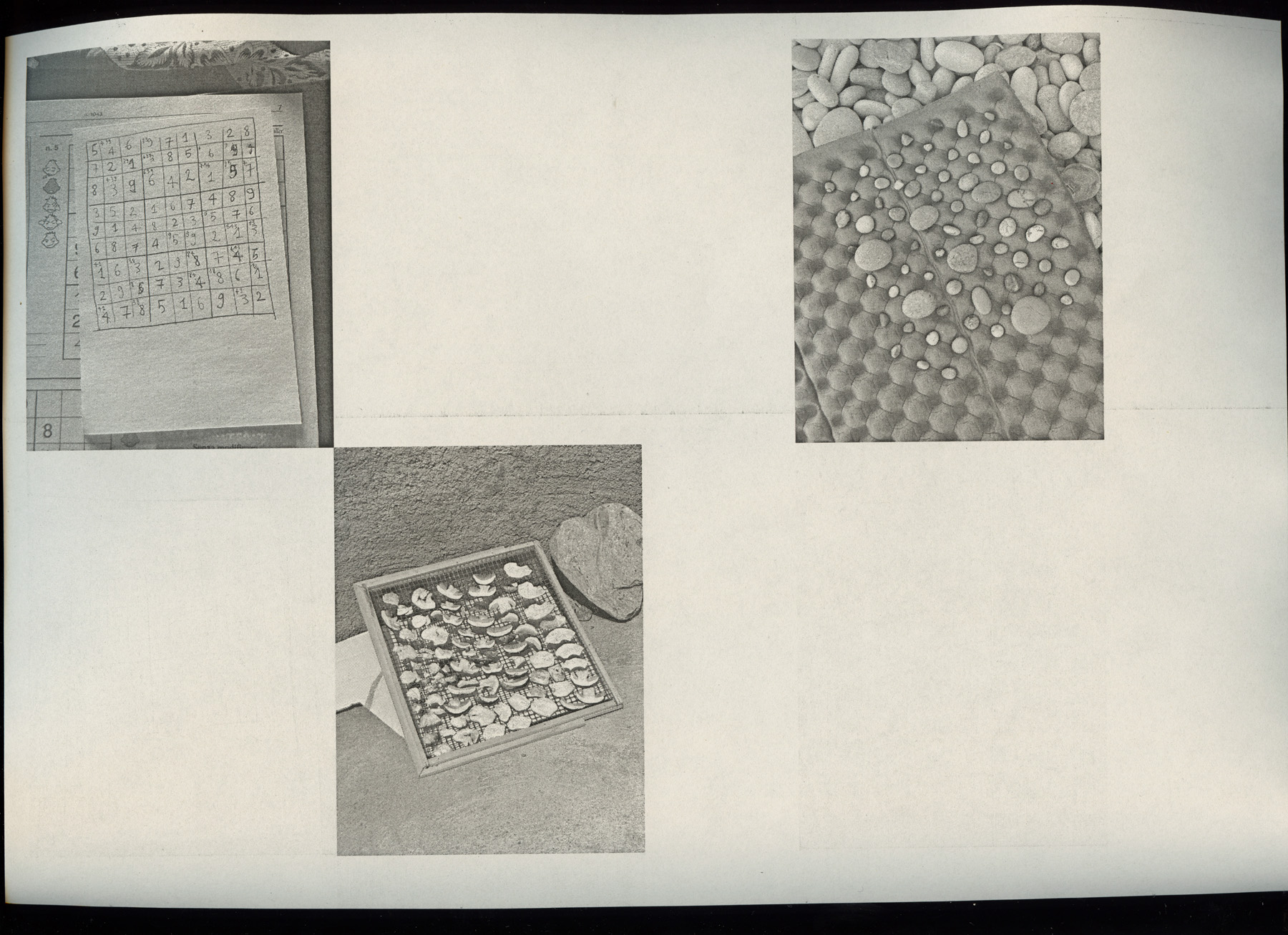
06/10/25
_Map and Territory
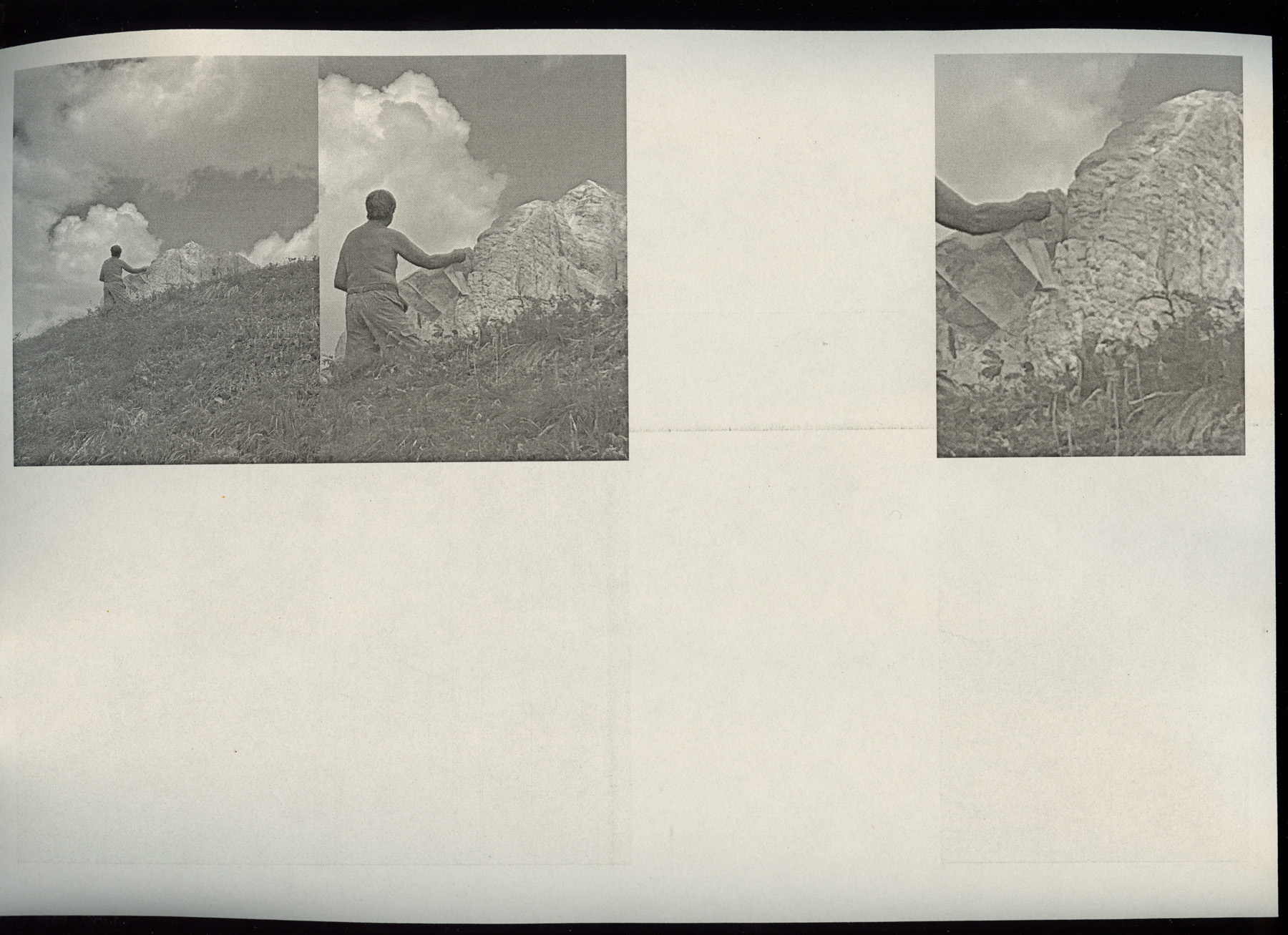
05/10/25
_Ready Moka
Every time I visit F, I get surprised by how fast the coffee is ready. It comes out of the moka so quickly and I do not understand how it is possible. I wonder if the moka is prepared with hot water or another secret, or if I just have a different perception of time in that home.
–
When in Topolove I appreciate when finding a moka pronta – ready moka. There is usually a post-it communicating the message. Someone already prepared it and if you wish for a coffee you just need to turn the fire on.
Grazie.
28/09/25
_Tra le cose da fare e da ri-fare
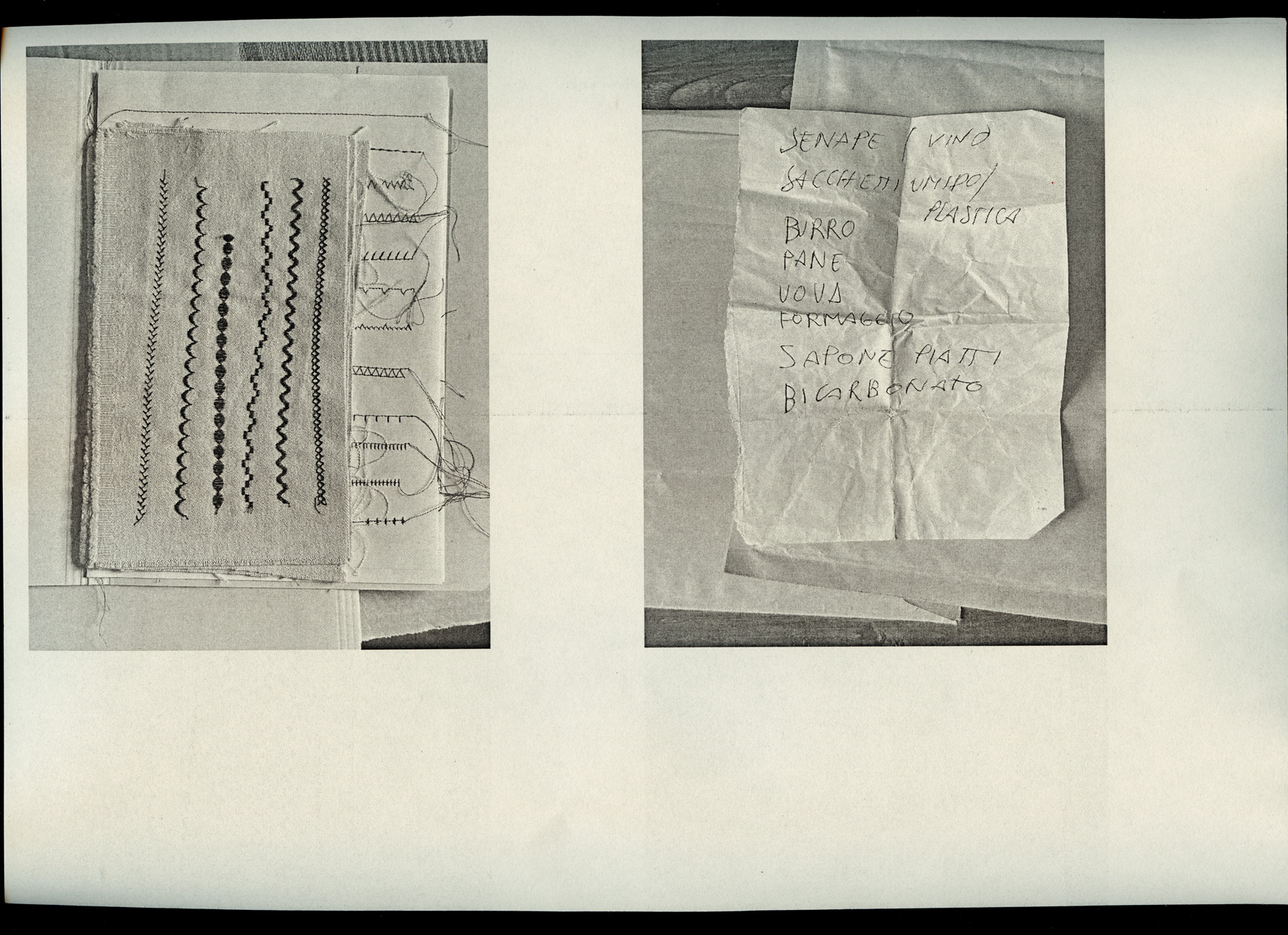
21/09/25
_When I Come Back
I noticed R sitting down the stairs after closing the door behind me.
He is an elderly small man with a high-pitched voice and a sweet laugh. I don’t often see him around Topolove, but when I do, he’s usually walking to or from his car or sitting on the – muretto – as he mentioned to me. He is always positive and makes me smile.
R first started talking to me in Swiss German and later switched to Italian. He often tells me stories about his time working in Switzerland, or about nice communal meals like the one – bellissima festa – of a few days ago. There was a long table full of food and drink, with lots of people celebrating around it.
As we talked, we slowly started walking towards the car park. While getting closer, he pointed to the yellow house and confessed that sometimes he walks unsteadily to make the lady looking out of the window think he is tipsy. He smiled and said it was nice to hear me laugh, and invited me to visit him when I come back to Topolove – “così prendiamo un caffè!”
12/09/25
_Possible Solutions
While waiting for my lunch to arrive at a small osteria, I overheard a conversation happening at the table to my right. Three women were discussing ways to remove yellow stains from a white shirt. One of them suggested putting dish soap on the stains for around half an hour before washing the garment in the laundry. “It will work for sure” – she reassured her friend, who was worried about her shirt.
12/08/25
_Luglio col bene che ti voglio

07/08/25
_A Decade
I have found a small printed photograph of the hills on the left side of Topolove. I have taken it from somewhere around the old school. At the time – about ten years ago – I didn‘t know I was close to Caffè Dora. I didn‘t even know what and who Robida was. I am glad I slowly started to get to know them and Topolove.
03/08/25
_Buonanotte

14/07/25
_Stone stairs
Walking down from – Scoglio delle metamorfosi (metamorphosis cliff) – one of the structures in the valley, we moved our steps down a stone stair. Both me and T immediately remained impressed by the presence, stability and dimension of the rocks composing it. We later discovered from S it had been built by the shepherd of the valley. For all of us it is majestic to see the work they might have done to move those heavy big rocks, from who knows where till there, to build that stair and be able to move on that mountain side.

07/07/25
_A passo di pecora
Driving down from Topolove in the direction of Udine we encountered a flock of sheep and started to move a passo di pecora – at sheep’s pace.
02/07/25
_Measures
While talking about grades and scales of reference in climbing, F told me that for a friend of him there were only two grades: ”passo” and “non passo” – literally: I pass and I do not pass.
09/06/25
_Verdi coincidenze

08/06/25
_Piuttosto

06/06/25
_Images
F narrates, his pictures are descriptions full of details. He has no photos to show me, or has never shown me any. The memories are vivid in his mind and take shape through his words.
03/06/25
_Bread bag
On the way to the train station T insisted on stopping at a special bakery along the road to get some pizzette rosse – "the most delicious ones in town” – he affirmed. I did enjoy them along the journey to the east. I also really liked the paper bag, a simple everyday element not only containing but also passing on a story.

01/06/25
_Three views walking back home

26/05/25
_Arc

20/05/25
_Lo stesso tempo
While I was walking through San Martino with a wheelbarrow Dante asked me if I had the driving licence. After reassuring him I just got it, I congratulated him for his beautiful vegetable garden I see evolving from the balcony. A farlo bene o a farlo male ci vuol lo stesso tempo – while smiling he told me it takes the same time to do it properly or do it badly. He and his wife (looking at us from their balcony) try to do it nicely every spring-summer.
16/05/25
_Dimmi dove, dove, dove
Di dove sei? – Where are you from? – Dove vivi? – Ma da dove vieni? – Are you from Sardinia? – Ma vivi qui? – I can hear a strange accent but I can’t understand where it is from… – I thought you were based in The Netherlands. – I see you moving a lot around. – Stai viaggiando tantissimo, anche io vorrei. – Dove sei ora? – I often look forward to a message from you telling me where you have been lately. – Ma sei tornata in Italia, o vivi ancora nei Paesi Bassi? – Dove si trova esattamente? – At the end of a road at the border between Italy and Slovenia. – Are you passing by or are you going to stay for some days? – Sei di passaggio? – I was just curious where you are based? – North east of Lake Como and Lecco, at the border between Italy and Switzerland. – Credo abbia senso che senti sia ancora il posto più familiare, ci hai vissuto a lungo. – Between the lowlands and the highlands. – How long did you live there? – Quanto ti fermi?
Then, sometimes I wonder what the place, or the places actually tell about a person that in the end is the sum of many places and moments.
14/05/25
_Cocola
Early in the morning I was in the lowlands, then suspended in between the clouds over the Alps. That day I remembered why I haven’t flown for very long at dawning: the stress of oversleeping and missing the flight does not make me rest at all. But that morning I somehow felt lucky for the notte bianca – sleeplessness and I took a train to the seaside. I felt I could not do anything else than spend some hours in the sun looking at the sea. In the past months I have came to Trieste a few times and I think it is really cocola – an expression of affection, admiration or appreciation towards something or someone one considers pleasant, typical of the local dialect.

07/05/25
_Almeno due – Two at Least
The rain was about to come and I drove to the forest for ‘our’ afternoon coffee. Even if he was doing così così – so and so, F came to open the door with his sweet laughter. We entered the kitchen that looked so empty and different compared to winter – since spring arrived he slowly moved all the plants outside. F prepared the coffee and a tiny pot of hot water. He delicately opened a small brown cardboard box containing some pasticcini.
As soon as we sat and started to talk he stopped for a moment and listened to noises coming from the entrance door. He said there was someone and slowly walked to open the door. Geppa – one of his chickens was there. Since Gertrude (another chicken) passed away she is looking for her around the garden. He gave her some bread and a caresse and promised her some grapes before bed.
We walked back to the table and an interwoven conversation about explorations and ways of living started. It is quite special for me to encounter F when I am here, it somehow makes me feel I am putting things into perspective and talking with someone that when he was my age had many things and thoughts in common with me.
Unfortunately as always, too quick and too soon, the clock showed the time for us to say arrivederci. “Devi mangiarne almeno due sennò non puoi andare” – before I could leave the table while laughing he insisted I eat at least two pastries otherwise he said that I could not go away. And while looking at the empty room he proposed to have a walk in the green houses next time I come. If it will be a sunny day we can probably see some plants blooming in there and he thinks I might like them. He wishes to organise a little trip too, but for now we enjoy another pasticcino.
03/05/25
_Today
Today I read somewhere: “non stare dove non fiorisci” – literally “do not stay where you do not bloem”.

02/05/25
_Attaccar Bottone
Signora L with her flowered summer dress and her bag walked slowly helped by a simple wooden stick to reach her spot in Barcola. As soon as she put down her towel she started to talk with a man she seemed to know, or someone she had met there many times. L talked about the multiple pains around her body, aware that she is 80 and she was not expecting to reach such an age. “Meglio morire vecchi che giovani” – while laughing she expressed how it is better to pass away when old then when young. But she also added that it is not easy to get old.
She took off the blooming dress, prepared a little soft yellow towel on the big one laying on the pavement, put a bit of sun cream on and slowly walked down the stairs to reach the sea. After a few minutes she calmly swam in the transparent water, went out far from the seaside, floated for a bit out there and when she felt it was enough she swam back. L reached her towel and laid down on it, letting the sun dry her body.
A lot of people seem to come to Barcola just for a few hours during the lunch break for a bit of sun and a swim. They come on their own or in small groups. Someone else might join, someone might leave a bit earlier. It seems they always reach the same spots and they therefore get to know some of the other people that like them come back. They talk and quite spontaneously attaccano bottone – literally sew a button, ask questions to other people there. It is quite interesting how as soon as someone talks to a stranger all the others get a bit silent and listen. A more private conversation it is actually very public. And when this one stops many might give a comment between their friends as it happened to me and A, definitely surprised by the energy of Signora L and wishing to get to 80 like her.
28/04/25
_On the Road, Again and Again

24/04/25
_Modern Architecture

05/04/25
_A dopo
“A dopo” – see you later. We almost never say ‘goodbye’ as if we will keep encountering each other in between the tiny alleys of the village. Even if we will encounter tomorrow or we do not know yet when we will meet again, “a dopo” is what we say.
It is very special to live in such a small reality and know that if you go out to Monica, Kunda or Franca you will encounter someone or more than someone on the way and maybe make a plan all together. I quite like to meet spontaneously. I wish to do it more and more.
18/03/25

17/03/25
_Second Sunset
“Il 14 di marzo il sole torna al campanile e dal 19 arriva anche al ponte.” – From 14th of March the sun, after it passed behind Pesgunfi Mount, gets back to the village and reaches the bell tower. From the 19th of March it also arrives at the bridge. “I miei nonni dicevano così” – it is something grandparents were saying in San Martino (Val Masino) when Franca was young. T calls it the second sunset.
“Ricordami come ti chiami” – gently F asked me again what my name is and since she is Franca she said it is very similar. I told her many friends call me like her – she will start too. While I was going out of the door she invited me to pass by to say goodbye before I will leave in the coming days.
11/03/25
_Chissà cosa fa
F has used the same harness since 1986. At the time their idea was to not fall. – “Non dovevi cadere!” – While smiling he told me that even dough M recently suggested him that he change harness, he feels safe using it and therefore doesn’t want to buy a new one – “Ma io non voglio, mi dà sicurezza”. To be slightly more safe he bought a kevlar lanyard that he puts with a knot around his waist. “Chissà cosa fa” – literally: who knows what it does. It is kind of a symbolic gesture that even he wonders what it actually does.
10/03/25
_Isn't It Beautiful?
We walked back up to the kitchen and started to talk. He made some coffee – americano as we both like it – and offered me some biscuits.
F works only during spring and autumn – stagionalmente. If he is out for work and they book him a hotel room he has a hard time sleeping. He doesn’t sleep all night. So, if he is with the van he prefers to sleep in it. “Non siamo fatti per stare sempre comodi” – he thinks we are not made to always be in comforting situations. With a cheeky smile and somehow pride he told me how he has always adapted and slept in many different situations. “Stendevi lo stuoino dovunque tu fossi – e via! È meraviglioso per me come posso dormire in molte situazioni diverse, non è bellissimo?” – Only by unrolling the mattress it was marvelous to be able to sleep in many places – “isn’t it beautiful?” – he asked me, probably imagining a confirming answer from my side.
10/03/25
_È tutto per questa sera
It was probably the first time I entered the wild forest in the daylight. The sounds and colors were somehow something new to pay attention to. I rang the bell and soon F arrived at the door holding a little bowl with some salad. He kept apologising because he still needed to finish feeding the chickens. After a few steps down to the basement we entered a room where Gertrude was waiting for him. The calm chicken carefully pecked the half grape F was gently drawing closer to her beak. When all the grapes were gone from the little bowl he showed Gertrude the open hands symbolising è tutto per questa sera – that everything was finished for the evening. He caressed her and wished her good night.
04/03/25
_Harvesting
The first primule – primrose with their bright yellow started to appear in the fields around Topolove. Signs of the starting spring that we collected and dried to drink as herbal tea during the cold seasons.

25/02/25

23/02/25
_Ephemeral Measures
With her arms, shoulders width apart, straight in front of her chest Nonna Maria – V and E’s grandmother, described to us the dimension of the roll of textile. And a few minutes after, while talking about a tea-towel, she drew a rectangle on the surface of the table by following with her hand the perimeter of the shape she imagined. She repeated the shape a few times to make sure we understood it.
22/02/25
_Ephemeral Maps
As it happens on Saturdays, R arrived in the kitchen for a coffee. While waiting for the bblbllblblblbl of the ready moka, he and V started to talk about houses in Topolove. To understand each other better and create a sort of map R positioned the pack of tobacco horizontally and next to it the lighter vertically. In between there was some space he described as the garden – quella era l'unica casa con il giardino – the only one next to a house in the village. The house was nicely oriented in relation to the sun and had a window on top of the lighter from which a lot of light was entering.
Some time ago I found myself in a similar situation at the – bancone del bar – bar counter where for S the stack of napkins, the bags of sugar and a spoon became elements to describe a specific landscape.
A moment after these maps are not there anymore. They exist only in that moment, with those objects around and accompanied by the words of that person explaining.
21/02/25
_Warm Spaceship Coming from the Past
During a night in the valley with T, the rubber hot-water bottle started to leak (because they have an expiry date and it can happen due to rubber wear) and a big chunk of the bed got wet. The day after this – malanno – mishap, while making a little rounds of antique shops and flea markets, we found an old aluminium hot water bottle looking like a spaceship. Using it, we immediately realised how much better it held the heat and the cold too (good for warm summer nights).
When a few days later I showed a photo to my mum, she immediately recognised it and told me that in Claut, the mountain village where she is from, my grandmother used to make one of those bed warmers for every bed in the house.
02/02/25

29/01/25
_Rosemary twigs
A gift before leaving.

26/01/25

21/01/25

18/01/25
La tovaglia della macchina
Continuation of the trace 22/02/24 – La coperta del tavolo:
“When T moved into a new apartment in the valley, the owner noticed there was no tablecloth for the table in the kitchen. A few hours later she came back and brought him – la coperta del tavolo – literally: the blanket of the table.”
A few days ago while walking around the neighbourhood where my parents live I found – la tovaglia della macchina – literally: the tablecloth of the car.

28/12/24
_Through F's Dark Forest
We entered the open fence and drove through the forest – as he calls it. Up on a few steps we got in front of the door and M rang the bell a few times – probably a sign of a kind of language they share to know and let the other know who is there. While laughing F arrived to open us the door. The laugh somehow came first and it felt very welcoming. This yearly visit to F to me almost feels like a tradition, something I look forward to towards the end of the year.
We sat around the big squared table in the kitchen. Soon we also stood up to observe all the plants he brought inside home to keep them warm during these cold winter days – some of them surprisingly blooming, like the orchid next to the table.
While talking about the stove in the kitchen and how little wood it needs to keep the room warm, F put a little pot of water on the fire and a moka too. He delicately put a cup on a plate in front of each of us. Blblblbblblbl – When the moka started to sound ready F turned off the fire and gently poured some coffee first to me – prima le donne – then to M and later to himself. He poured some of the hot water into mine and his cups – lo preferisco americano – a detail I remembered from last year. He really wished to play cards together and I promised next time we will play briscola.
There is always a certain light and joyful energy, sometimes I wonder if it is also bittersweet. I don’t know him well, I have only visited him about three times but he seems a very simple, kind and generous person – di cui alcuni approfittano – which some take advantage of – aware he expressed. In between the discourses and laughter around the table sometimes an exploration to Cile, Perù or Patagonia comes up. A trip to Cerro Piergiorgio – non sapevamo come sarebbe andata, abbiamo preso i biglietti e siamo partiti all'avventura – without really knowing what to expect and ending up walking two days to reach the base of the wall, climbed five or six pitches and then started to walk back for two days because a storm was about to come – tutto faceva parte dell’avventura – everything was part of the adventure.
From some of the discourses he seems surrounded by friends and glowy, but in between some other of his words I feel he wishes for more company – complaining about M not being able to visit him so often as he was used to. I wonder if he regrets not living and sharing his life with someone. It is interesting though to see how he laughs about this whole.
We walked in the dark and reached the shed. It was cold and we first continued to talk while we gathered around the stove. Then we slowly started to warm up and climbed a bit. F tried to climb a bit too even if – è tracciato troppo difficile qui per me, ormai non vengo più – it is a bit too hard for him and he does not climb much anymore, only when we visit him.
Then he left to go put some wood in the stove in the kitchen and when we were about to leave we encountered him in the dark outside home coming in our direction. For a moment the electricity in the neighbourhood went off and he started to worry about the gasoline stoves in the greenhouses – hanno bisogno di elettricità per andare – keeping the environment warm for all his plants.
We hugged and then he went inside looking for a torch or a candle – till next time when we will play briscola – as promised.
30/11/24
_Floating Canin
While driving to Topolove during sunset, far away in front of us Mount Canin appeared covered in snow. In between the blue mountain below and the blue sky above it seemed suspended, like an island surrounded by the sea.
19/11/24

17/11/24

13/11/24
_Blue Pietruzze
On top of the village, after the church, we took the path to Livek. At a shy crossroad we went to the right following the trace of a path we could barely see and we weren't sure was the right one. After some time, far away on our right we could see the little fountain we were looking for. In 1985 R. decorated it with some blue and light blue pietruzze – little kind of stones. In the past, if in the village water was missing, that was the only little fountain in the forest where water would still run.
On a rock close to the fountain he also built with some rocks a little altar. The floor is made with the same pietruzze and inside he placed a little statue he had found somewhere.
Vida told me R. once expressed he doesn't like those over decorated tombs in the cemetery, he instead would like a very simple one – decorated with just his simple pietruzze.
12/11/24
_Traslochi
“When you leave a place you always find something you forgot having (one of the many reasons why I like ‘traslochi’).” – Gioia Guerzoni
A few days ago I was going through the boxes of my trasloco – moving – and even if not much time has passed since the day it happened I was joyful finding many of my little belongings – each of them carries a story.
11/11/24
_Path
Autumn has arrived in and around Topolove. After a summer of living outside, in between the houses and the tiny plebby pedestrial vicoli of the village, we mostly gather inside the rooms warmed up by the fire. It is quite fresh but there are still a few hours during the day in which it is lovely to be outside in the sun.
After lunch is one of the last moments before the sun gets behind Mount St. Martin on the right of the village. I went for a walk to the border between Italy and Slovenia and as soon as the road became a path it was hard to see it in between the blanket of dried leaves covering the ground of the forest.
03/11/24

28/10/24
_Salutare
In some moments it is just a gesture of the head going slightly down and then up, or a smile. Sometimes it is a ‘salve’, other times ‘buongiorno’, in some cases ’ciao' and towards the evening ‘buonasera’. I started to greet everyone I encounter while walking from one village to another and around the villages. The relation with people I meet along the way has another dimension in these valleys compared to the one I can have with people in the cities. It is special to somehow start to greet unknown people because you encounter each other in this small or just smaller reality.
‘Salutare‘ in Italian means to greet and it is also something that is beneficial for the health.
27/10/24
_Così così
Così così – so so – sosolala – she said while twisting horizontally the open hand as if she was whisking the air in front of her.
24/09/24
_If M is wearing the hat
While driving down from Topolove on our right we saw Mount Matajur covered in misty clouds. Vida said: La nonna dice: “Se il Matajur ha il cappello, pioverà.” – if Matajur is wearing the hat it means it will rain. Over night a tic tic tic on the roofs and leaves announced the presence of the rain.
09/09/24

06/09/24
_Above the tree-line
We went high up above the tree-line, where no more trees grow but only small bushes and wild thyme. In a very green flat surface of grass a river was flowing coming from waterfall descending from somewhere we couldn’t see. Slowly the dark embraced the peaks around us and let us see some fireflies emitting their magical light even up there.

22/08/24
_Due Chiacchiere

One of the first photographs of Topolove that I found on my phone is a little bench on sloping terrain in front of an abandoned building. The bench is on one side supported by a pile of stones – the steps of a little stair – and on the other by two legs in the shape of an inverted V. As the terrain, the bench is slanted too.
During the warm summer days, every morning Nadia ‘la padovana’ – lady from Padova – arranges her outside living room. In a plastic bag for the grocery she carries two pillows that she precisely places on top of two steps of a stair that leads to an abandoned building in front of the entrance of her house. One is white and one has a bordeaux pattern on it. She often sits there on her own and does the routine calls to far away friends and sons. Sometimes another lady from the village sits there with her for due chiacchiere – small talk.
Nadia has a strong accent and a loud voice too. I can hear her while she walks to the trash bins at the car park – surprised about the beautiful little light blue flowers along the path. Come delle minuature – like miniatures, these flowers that in her memory weren’t there the previous year bring her so much joy.
At the parking lot there is also a strange assemblage of elements on the ground. A silver reflecting surface with a folded part like a triangular mountain coming off the ground. Two big stones placed on the flat parts don’t let the sculpture move away with the first blow of wind. It is placed in between two cars and it is definitely a sign of car park reservation for and made by Ornella.
19/08/2024
_Pôc
“Pôc al é pi de nuia...” – a little bit is more than nothing.
07/08/24
_Drawing the Invisible
“Buongiorno, io salgo in legnaia” – a morning message from B that for someone who doesn’t know him could sound as if he is going to a place where wood is collected for the winter. Legnaia from legna (wood) is the woodshed, and legnata is the sound a piece of wood can evoke when slammed against something and in Italian it is also used when someone also metaphorically gets beaten.
Legnaia is a special place discovered, imagined and slowly – with patience, passion and steadiness – created by B. It wasn’t there, or better it was not yet visible, until during one of his explorations around Topolove he entered it.
During a calm and fresh summer evening we created a map of Legnaia, overlapping red lines to a precise black drawing of the rock, cracks and trees. Lines he first imagined looking at the features of the rock, then tried to follow with movement of his body up the wall and that were now becoming traces on paper for others to move along them.
On another evening during the summer, guided by E we walked in the dark of the road after the cemetery with big pieces of paper, black paint and bright lights to look for shades. Directing the light against flowers and plants on the sides of the road, shadows of lines and elements appeared on the paper lying on the ground. With the brush we tried to impress those ephemeral elements on the paper. Every little movement of the light, paper or plant was creating variations. When the lights went off and we moved the paper, what we were seeing before wasn’t there anymore, only traces of those elements that were there for little moments.

25/07/24

07/07/24
_Swallowing Geography
“I have written a book of linked stories called Swallowed Geography. [...] Each new journey is a mourning for what has been left behind. The wondered sometimes tries to recreate what has been left behind, in a new place.” – Deborah Levy
04/07/24
_Ritornando, returning
“[...] Cuore, when returning from a long trip, after a long absence... you'll see the great blue mountains of your country; you will feel it then the impulsive wave of tenderness that will fill your eyes with tears and rip a cry from your heart.
[...] The word ‘homecoming’ has always perplexed me. In Italian we have only ‘ritornando’, ‘returning’, as though nothing has changed – neither place nor person – in the interim. ‘Returning’ is wishful thinking, a romance in which every character has one true and rightful place.”
24/05/2024
_Making Space for More Traces to Come
Slowly unboxing. Slowly packing. It is confusing to go through boxes of memories and traces from all these years in the lowlands. It brings up multiple emotions for all the different moments every trace represents. It puts me in the position of choosing what I wish to take with me, how I want to remember certain things. Which are the traces I wish to carry?
At the same time, this cleaning, choosing and creating space makes me feel tingles for what is not-here-yet and what will soon come. In some moments I wish for time to slow down and let me enjoy this special time, in some other I wish for this a bit suspended time to be over and enjoy what I am waiting for.
22/05/24
_Strawberries Time
In his kitchen facing the water, almost floating on it, we were preparing the white round table for lunch. K looked at me and raised his arm with a finger pointing to the ceiling as a sign of an idea or something he just remembered. Then he walked behind a wall where I haven’t been and came back with a box full of red strawberries. After the savoury part of the meal he toasted another slice of bread, cut it in half and took a few strawberries he gently placed ‘standing’ on top of the bread. With a fork he slowly meshed them in a puree and sprinkled some brown sugar on top. Dessert was ready and with the use of a knife he cut it in pieces and enjoyed it.
03/05/24
_At the Bookshop
Sometimes at the bookshop friends pass by, lately when I encountered some of them, they happend to say things like:
“I thought you were in the mountains.”
“I thought you moved.”
“I wasn’t expecting to find you here.”
11/03/24
_At the Border
The train where I am sitting is travelling through high mountains covered in a soft white blanket of snow. It is around lunch time and the white surface covering the landscape reflects the strong sunlight. Quickly I get misty eyes. Then little tears. I wonder if it is because of the snow reflecting the light, because of travelling through this suspended landscape or because I am once again crossing a border to get from one place to another, from one identity to another.
The loud speaker of the train announces we are reaching ’Ospizio Bernina‘, a stop at the border. A language border between an area where Italian is the main language and another area where Rumantsch and German are mainly spoken.
I often find myself at the border. At the border between Italy and Slovenia. At the border between Italy and Switzerland. Once I spent a month at the border between Switzerland, Austria and Lichtenstein. I am often at the border between Italy and The Netherlands – a fictional border that, even if it is not visible on any existing map, I quite often experience to cross. A line between the lowlands and the highlands. A space of transition, where I reflect about what just happened and 'the' not yet.
22/02/24
_”La coperta del tavolo”
When T moved into a new apartment in the valley, the owner noticed there was no tablecloth for the table in the kitchen. A few hours later she came back and brought him – la coperta del tavolo – literally the blanket of the table.
17/02/24

27/12/23
_Leaving Traces or Deciding to Leave Flowers Instead
Fiore (flower) as F, in the end it is also the initial of his name
“Tomorrow I will go to visit F with my friend M, would you like to join?” – At the time I didn’t know who F was and had no idea what to expect from this encounter, but on a foggy winter afternoon with my bicycle and some biscuits in the bag I reached his address.
In between a ‘forest’ of plants coming from all over the world there is a small fence that leads to a house. F hides there or maybe – escapes – as he would say. In the past he would do it in the mountains, now, because of his age, he can do it less and less out there. He spends time in the greenhouses he slowly built and filled with plants and seeds collected during his expeditions, and dedicates a lot of time taking care of his dear chickens.
We had a coffee sitting around the table in the kitchen. There was sugar in the little white and red ceramic pot, but he put sugar – quanto basta – directly from the white 1kg paper bag and a moment after he walked to the stove to get a tiny pot and added some hot water – per fare un po’ come un americano. He is an elderly man, the hair was covered by the knitted hat he was wearing from which some of his grey curls came out on the backside of the neck. The spoken words were constantly accompanied by many gestures. His hands looked strong, or were strong – as he mentioned – now the left one is a bit delicate, it does not allow him to climb much, just one or two passages in the little gym in the shed in the garden.
He smiled and told us little episodes of life, but at the same time he doesn’t like to talk much about himself. M knows him well and maybe only because he was there, F told a few more things about when he was younger, with energy and desire to be against, to be free, to do what he-they wanted and to simply explore out there – in the mountains. There was no desire to tell others, no desire to document – se facevi qualcosa, stavi zitto. The guide books would give just a few little details about routes and when out there it would always be a very personal adventure and certainly different from the one other people had there. He didn’t want to leave any trace of himself and still does not – not telling anything to a mountain guide curious about some routes he opened or repeated in his life. If there was a book to sign on top of the route or the mountain he would draw a flower and his companion a boat – he told us while laughting with his cheeky eyes. – And I thought: ‘fiore’ (flower) as F, in the end it is also the initial of his name.
He insisted on telling us how different it was when they were going out there for their personal desire to explore because all they wanted was that life for themselves and not because they discovered it by looking at how others were living. He moved and explored a lot, or this is what I felt, and probably only his companions of adventures know where and when. M tried many times to convince him to write a book, and in between joking and being serious, the three of us around the squared table mentioned it again and in the end, while laughing, the negative answer came once more.
Even if F doesn’t want to leave traces, I think by being and encountering us and others he is and will always leave many behind. By telling little episodes of his life he is giving us the opportunity to see and imagine a different way of living that for sure happened in another time but was and still is, for the ones that can know something about it, an escape from the present reality.
On the left corner of the table there were three books and a pair of glasses, one of them opened “Alla scoperta delle Prealpi Carniche”. He passed it to me and M sitting in front of him and I thought that reading is also a way of escaping. When I am in The Netherlands I do it all the time, reading about the mountains allows me to feel closer to a place, culture and way of feeling that I miss a lot. Little fragments that constantly allow me to see other possibilities. Maybe he had always been reading too, from all the books he suggested to me I would say so, and in doing it he might also found other possibilities for himself in the stories of other people.
We entered the shed and climbed a bit in the small bouldering gym. Then F suddenly opened the door and appeared gently holding the rooster in his arms and caressing him – voleva salutarvi prima di andare a dormire – he wanted to say goodbye before going to sleep. Then they left, till next time.
Maybe I will start to sign with a flower too, in the end Francesca starts with F as well. And in the end beside the flowers he drew on all those notebooks, there are always many in all his greenhouses – traces of his explorations and therefore of himself.
12/12/23
_Un pensiero

Last winter I received a beautiful, delicate embroidered cotton handkerchief as – pensiero – a thought. It was of a dear grandmother that passed away. It is so beautiful how these little, light, pretty elements can be kept for years and years in the secret pockets of different people and come out from there to dry tears or dripping noses.
A few days after at my parents place my mother saw my hand slowly reaching the right pocket of my pants to get the flowery handkerchief and as soon as this reached the light and she could see all the little flowers she wondered – Da dove viene quel fazzoletto così bello? Di certo non dalla mia scatola di sopra. – when she heard it was – un pensiero – for days she recommended me to give 1cent to whoever gifted it – altrimenti porta lacrime – otherwise it could bring tears.
I think the italian way of calling this little gesture of gifting – pensiero – is so beautiful. Pensiero means ‘thought’ and to me it really represents the moment in which I see something and it immediately makes me think of someone. The gifted object becomes a symbol of the gesture and probably for the other person will always remind them of the special moment of the donation – interconnected thoughts.
30/11/23
_The Deep North
“At first it wasn’t clear. No truth. No belongings. The was snow on the trees, rooftops, streets and that grey light you see in old movies set at sea, where ice floes break the boat apart. This to me is the image of knowable. Ropes and stripes, black and white, and what you look at, looks back. If it’s a dream, or if it’s what actually seen, then it comes to the same thing: broken language, foreign syntax, the incomprehensible natura of the world. Anyway I didn’t even want an answer, that’s a fact. All answers are hells. I just wanted to locate the process that underlay the surface image, to put my hand under the top without looking at what let out. Whatever it was, it didn’t belong to me. That is the nature of truth.” Fanny Howe, Radical Love.
28/11/23
_Path n. 2811*: A walk On A Fragile Territory
To my dear mountains
Table of Contents
1. In order to follow the signs you need to know the language.
2. One after the other.
3. How long does it take?
4. Slow thoughts, fast thoughts.
5. What is under my feet?
6. Layers on top of layers of: a fragile territory.
7. A landslide. A hundred meters lower from where it moved from.
8. I wondered where the fragments were moved to, what they had become.
9. Residual. Hidden histories.
10. Memories to reassure myself about my solidity.
11. The mountain outside have no fear.
12. Solid as a rock. Stai saldo come una roccia.**
13. As if something had cracked inside me and my experience is leaking out.
14. Put a stone on it. Mettiamoci una pietra sopra.
Afterwords. Working–walking on it.
Bittersweet.
*A path is a sequence of points in space. The text is written as a sequence of sentences, a list, an index.
** “Through the spectacles of geology, terra firma becomes terra mobilis, and we are forced to reconsider our beliefs of what is solid and what is not. Although we attribute to stone a great power to hold time back, to refuse its claims (cairns, stone tablets, monuments, statuary), this is true only in relation to our own mutability. Looked at in the context of the bigger geological picture, rock is as vulnerable to change as any other substance.” Robert Macfarlane, Mountains of the Mind.
A text written a few year ago as a contribution to PUB Journal #3: A Pack of Lies, Amsterdam (NL), 2020.
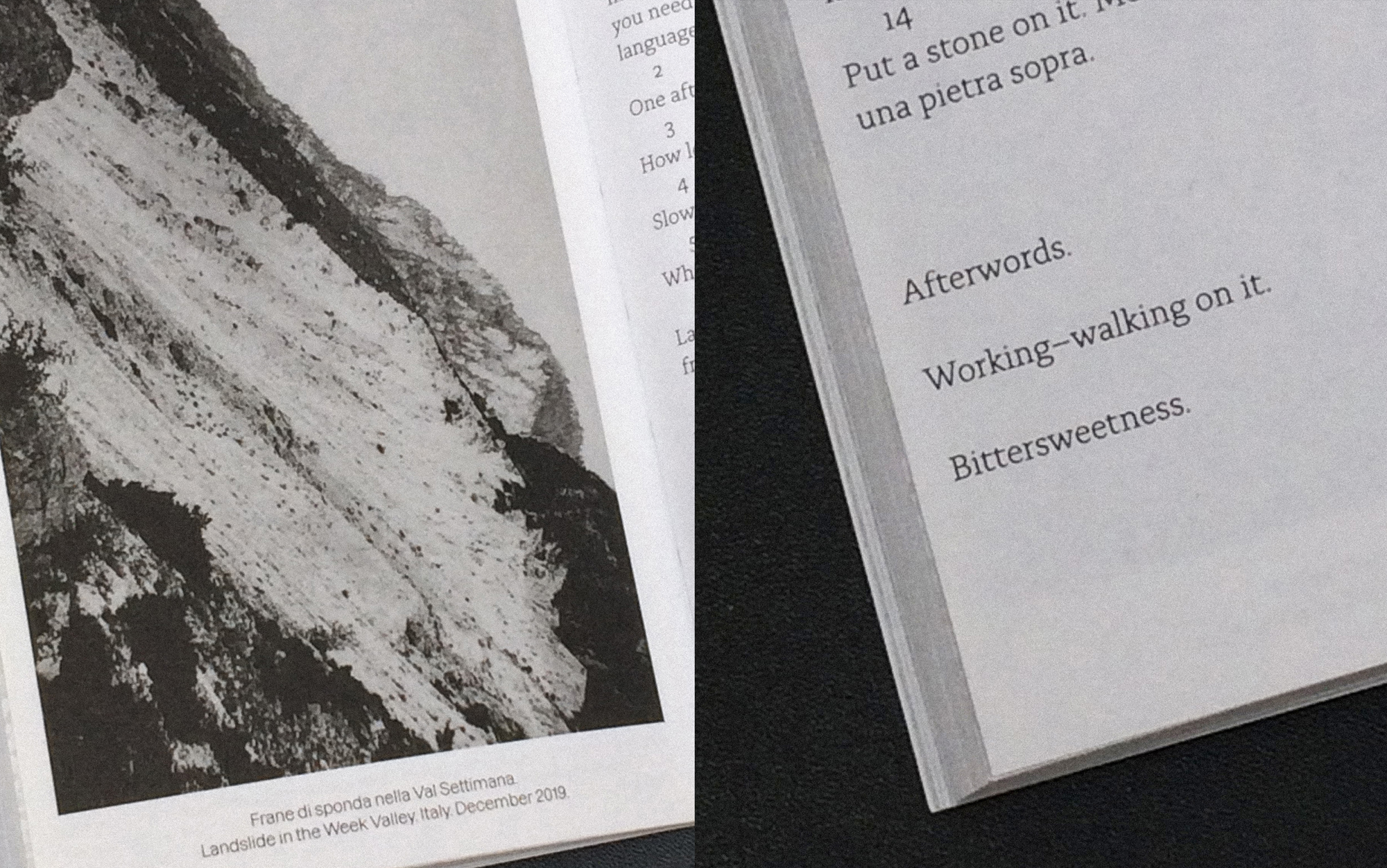
13/11/23
_Faraway Nearby
While the chestnuts were falling from the trees and we collected them along the path, the landscape around the village was shifting in its colours and atmosphere, slowly becoming more calm and more of warm shades of orange and brown. Even if the memories are still vivid, the time spent in autumn in Topolove seems faraway and it is somehow a little moment in the morning, the one of imagining again the view out of the window.
“For many years, I have been moved by the blue at the far edge of what can be seen, that color of the horizons, of remote mountain ranges, of anything far away. The color of that distance is the color of an emotion, the color of solitude and desire, the color of what is seen from here, the color of where you are not.” – Rebecca Solnit, A Field Guide to Getting Lost
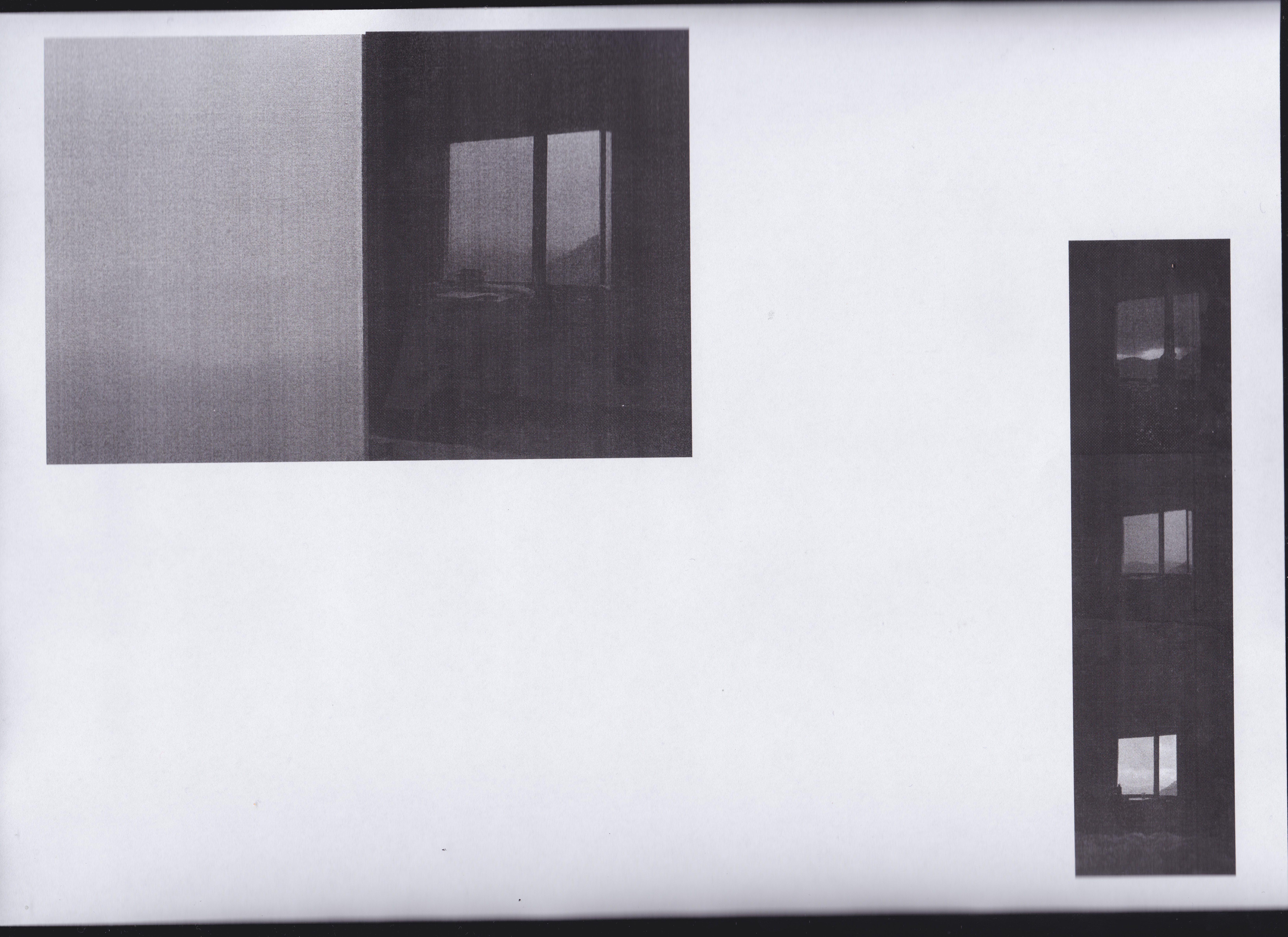
03/11/23
_”9000 metri sopra ai prati”
I still remember the first time we talked about Val di Mello – “We will go there soon” Teo said. Then I left Italy with a long train journey directed to the lowlands not knowing when it would have happened and spending the time away reading and researching about that valley and many other ones.
It is somehow still very beautiful to live in two different places, it gives the chance to miss and appreciate different aspects of both. When I am in the mountains I love to be in motion, while when I am at ‘baita’ in Amsterdam I really like to spend time researching and reading, it is somehow a way to prepare myself for future explorations.
“Maps give you seven-league boots – allow you to cover miles in seconds. Using the point of a pencil to trace the line of an intended walk or climb, you can soar over crevasses, leap tall cliff-faces at a single bound and effortlessly ford river. On a map the weather is always good, the visibility always perfect. […] A map can never replicate the ground itself. […] Maps do not take account of time, only of space. They do not acknowledge how a landscape is constantly on the move – is constantly revising itself.” – Robert Macfarlene, Mountains of the Mind
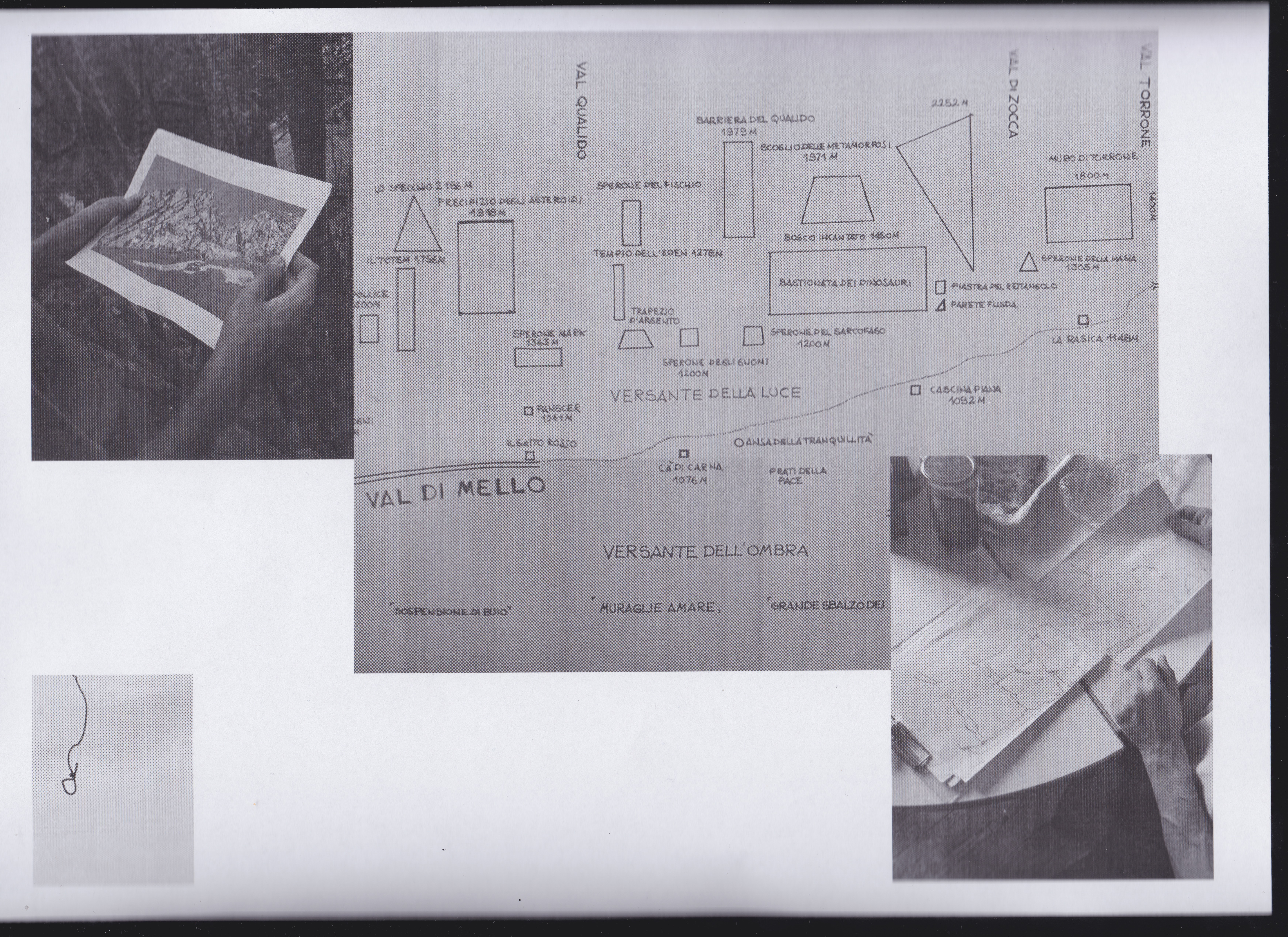
24/10/23
_Pisdaria
“I found a pistaria.” – “What is that pisdaria?” – “Look how many pisdarie.” – “Here we will put some pisdarie.” – “I woke up feeling a pisdaria on my left leg.” – “Look, this is such a pisdaria!”
I have been hearing Ali saying pisdaria once upon a time and then one afternoon its sound suddenly caught my attention. I started to repeat it, not knowing exactly what it meant. It became a synonym for thing, element, moment, word, feeling – one that is a bit familiar, little, light and simple. Something that, all the time it was repeated, would make us smile.
In these past months I spent quite some time in Topolove and something very special about the life there is its multilingualism – languages intertwine in a natural way creating many threads of discourse and in the end one big conversation. During a meal around a table it could happen that a sentence is in Slovene, the following one in Italian and the answer in English. In relation to who is present, there can be more or less languages used and contaminations between these. I find very fascinating and beautiful how language evolves in groups of people spending time together and how the meaning of a word like pisdaria can be familiar and understood by the specific group that has been together in a certain moment in time-space.
*I read some parts of Natalia Ginzburg, Lessico Familiare everytime I come back to the north east of Italy. I wonder if it is because I never put it back to the bookshelf and always find it on the comodino next to the bed at my parents place, because it cuddles me in a cozy feeling of nostalgia, or because I just like to read through it again and again.
15/10/23
_“Aria sognante”
On the vetrine on the left of the entrance door there is a very coloured drawing made in pencils of two figures. One has dark hair, a pair of striped yellow and blue pants and some pink shoes; the other one has very long blond hair, a skirt and some pink shoes too. All around them gray textured shapes – rocks.
Blaso found the drawing on the floor in front of the door the day after he brought Memi, a child of six years old, to climb.
While going to Blaso's place I met her walking around the village and so I asked how her first climbing experience went. She was very excited about it and after asking me ”dove stai andando?” – “where are you going?” – she came with me to visit Blaso. As soon as we reached the door and he came out she started to talk about climbing and how next time she wishes to go with the skirt.
I immediately thought about “Le Sorelle Grassi” (Grassi sisters) – three strong alpinists that between the end of the 19th century and the beginning of the 20th Century defied prejudices and conventions in the name of their passion for the mountains. In those years Angelina, Giacoma and Anna Grassi, were some of the only women that were going to the mountains for pure pleasure and for this they had also been criticised and envied. Their desire to climb was fulled also by the self-assertion of female mountaineers in a world dominated by men and maybe this was enriching their mental strength and allowing them to resist through fog, a night bivouac, hail, thirst in the long ascent of Mount Canin in 1899 guided by the geographer Marinelli.
“[...] Le lunghe sottane della quali si impigliavano nei rocciosi sporgenti e meno male era quando uno strappo più forte del consueto le lacerava, seminandone i lembi qua e là." – "The long skirts became entangled in the rocky overhangs, and less bad it was when a stronger tear than usual tore them, scattering the flaps here and there.” Says Marinelli in a letter to a mysterious I.P. friend. – leaving traces of their passage up on the mountains. Other signs about their ascents are possible to find on the diary-books that is possible to sign on top of most peaks, as in the one of Mt. Antelao wrote in 1880.
"Aria sognante" (dreamy gaze) – says one of the captions of a photograph that accompanies the text of an article in the magazine Le Alpi Venete, spring-summer 2018 – maybe towards new ascents. After every adventure a new one attracts the attention and the desire to continue exploring keeps being vivid – I feel this myself and I am glad the perception and prejudices of womxn exploring has and is still shifting. I am grateful I can be in the mountains for personal desire and pleasure. I often think I would like the passion for studying culture related to this environment and actively exploring it to become more part of my work. Maybe with living, maybe with writing, maybe with publishing – dreamy gaze.
04/10/23
_Transitions
For four years now I have been travelling around Europe by train. I started during a difficult time at the end of 2019, when during an afternoon where I was supposed to book my flights to go back to Friuli Venezia Giulia for the end-beginning of the year, I had the idea to check if it was possible to return by train. I somehow desired to travel with interrail for a long time and never really found companions for it. At that moment, even though my family was responding quite skeptical about my plans, I guess I found the courage to get on the train on my own and I was quite excited about it. I still remember the goosebumps during the trip and how I had to run to catch the last connection in Munich – a night train that in the early morning brought me to my hometown with the daylight creating her space in the dark sky.
On the way back to the lowlands I travelled to the middle of north Italy and then through the lakes and mountains of Switzerland. From there, the landscape slowly changed: all the rocks and high views became linear with a wide horizon. The way of looking outside shifted from wandering up to looking far away searching for elements to catch the gaze.
Since that time I only moved with long train journeys, it helps me process where I am going, what just happened and what is going to happen. I love to sleep on the train and wake up with a complete different view surrounding me and all the time I am so joyful of how they make me improvise encounters, visits and shifts of plans – meet friends for breakfast, lunch, a beer or a cappuccino and then continue to other destinations. Often the journeys are a moment to read, write and plan. They are a melancholic time during which I realise how much I will miss certain people, situations and ways of feeling and I wonder when it will be the next time I will be able to feel and live all this and more.
One of the last times I took a flight I was writing my master thesis “Alternating Layers of Ashes and Limestones: eroded, carved and scattered” – a combination of past and present documents, scientific knowledge with popular mythologies, landscape modified by weathering and by human kind. It is a geological, cultural and historical stratification and shows a parallel world suspended between experience, desire and imagination. The space analyzed and explored is the mountain area (natural alpine area) in the Province of Pordenone, Friuli Venezia Giulia Region, north-east of Italy. It is an area close to my own town Pordenone, where I have been since I was young, first with my parents, then with friends.
I remember thinking and writing: “On my flights back to Italy, I used to wait to pass over the Alps. The plane would offer a completely different point of view of a reality I had seen so closely. In the beginning it was spectacular, but after a while I started to refuse this image; it showed this mountain range as beautiful and untouched, perfect even; slowly creating an illusion.”
Still in-between: “In an attempt to find the connection with a distant place, I used my time in The Netherlands to study and expand my knowledge of places I’ve visited in the mountain, to organise the explorations I would do next time I go back there. I understood that a landscape became stunning when I knew what I was looking at, when I experienced it with the fog, the wind or the rain which created a completely different atmosphere from the ‘usual’ sunny days. Living between two different countries allowed me to build a relationship with the mountain environment and to appreciate it differently and more deeply once I was back. Even if only for temporary moments I immersed myself in the mountain landscape, I consider nature as a way to live and share experiences with others and as a possibility to build a common memory.”
28/09/23
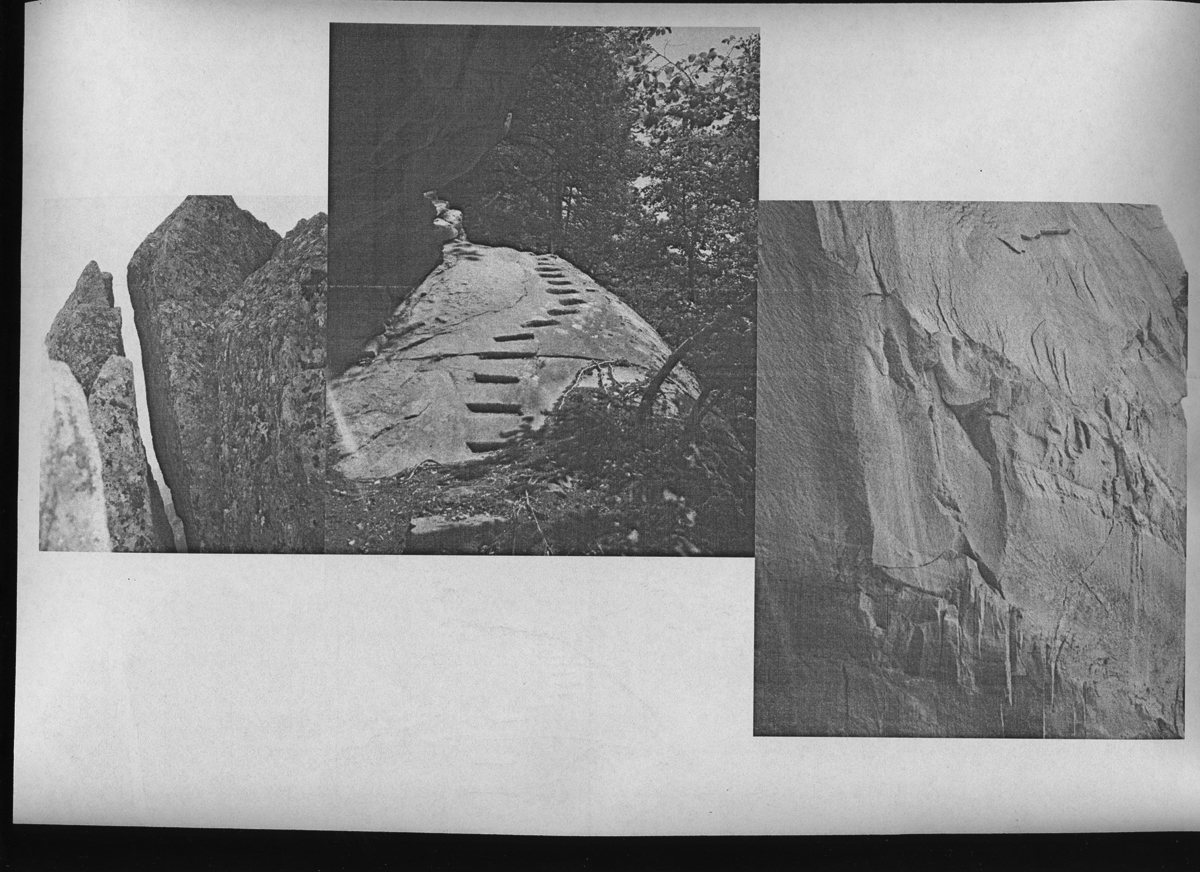
”I have been changed” – “You change me. Do not take me for granite.” – Ursula K. Le Guin, Being Taken for Granite
23/09/23
How Many Repetitions Are Enough to Maintain a Path?
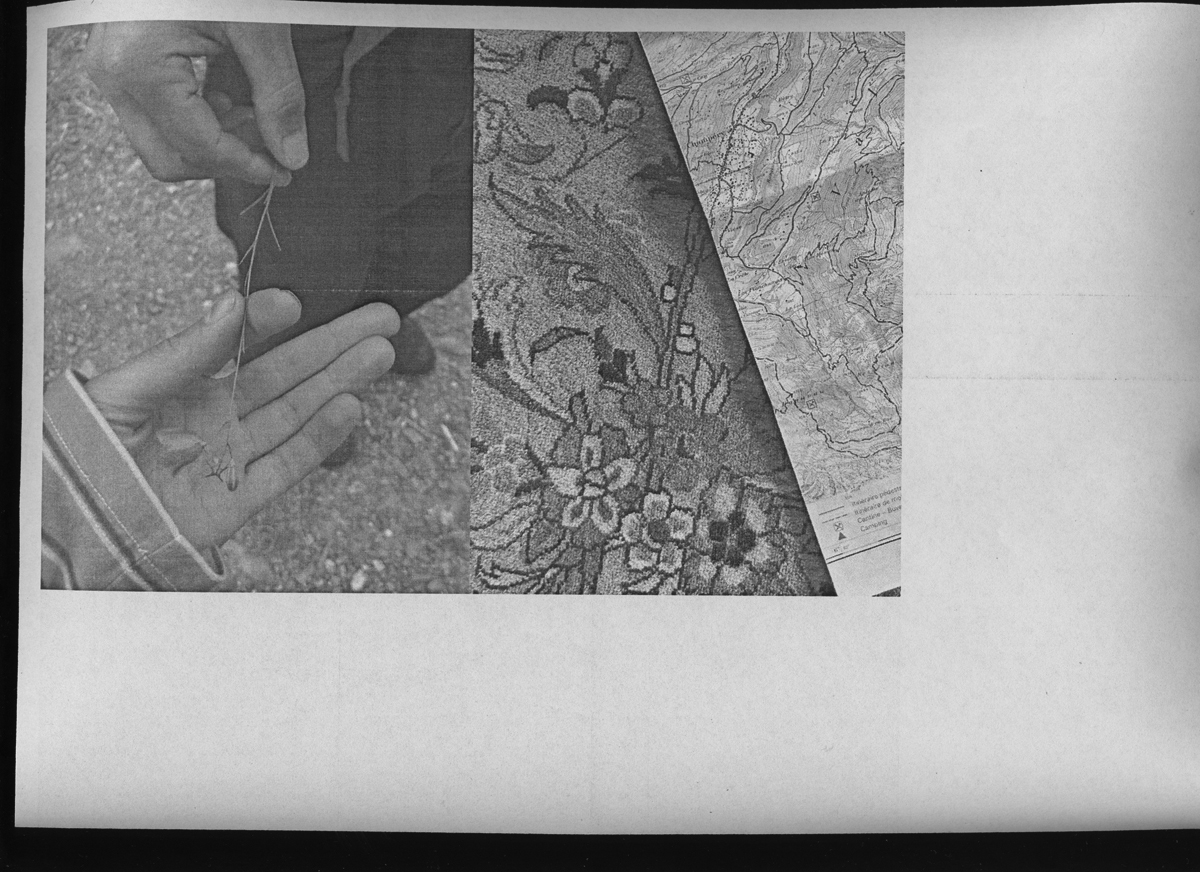
20/09/23
_Places and Identity
p.20 – “Always you will be asked for your story: after (the accent twigged) ‘Where are you from?’ comes ‘And what brings you here?’ – because, so the thinking goes, this story defines the individual, for better or for worse. You are the embodiment of your story and if people don't know the beginning or middle, how can they predict the end? May you stay? Must you go? You will probably have a long version and a short version and both will, over time, be well rehearsed.”
I am a different version of myself in Italy to the one I am in The Netherlands. When I move between countries or cultures I sometimes imagine it as a process of splitting. There’s some behaviours, ways of saying, ways of organising time and moving around that are so different that they make it feel I need to be a different version. Sometimes I am much calmer, sometimes I have so much energy that it is difficult to direct it. In some situations I can be very shy and silent and in others open to encounters and conversations. In both places I can feel nostalgic about something on the other side – a romantic view to where I am no longer. “Nostalgia, she says, can prevent you ever truly ‘arriving and unpacking’ anywhere else. But you can't go back either. 'Nostalgia' joins together the Greek words ‘nòstos’ and ‘àlgos’, ‘homecoming’ and ‘pain’. It is painful because you intuit that the return is impossible. You need to find a way of ‘mediating’, my friend says, of 'reconciling' the different aspects of yourself.”
I wonder if taking into consideration the context will push you to re-considering so much of a different way of living and relating-with-the-other.
And, in the end, I wonder Where am I from?
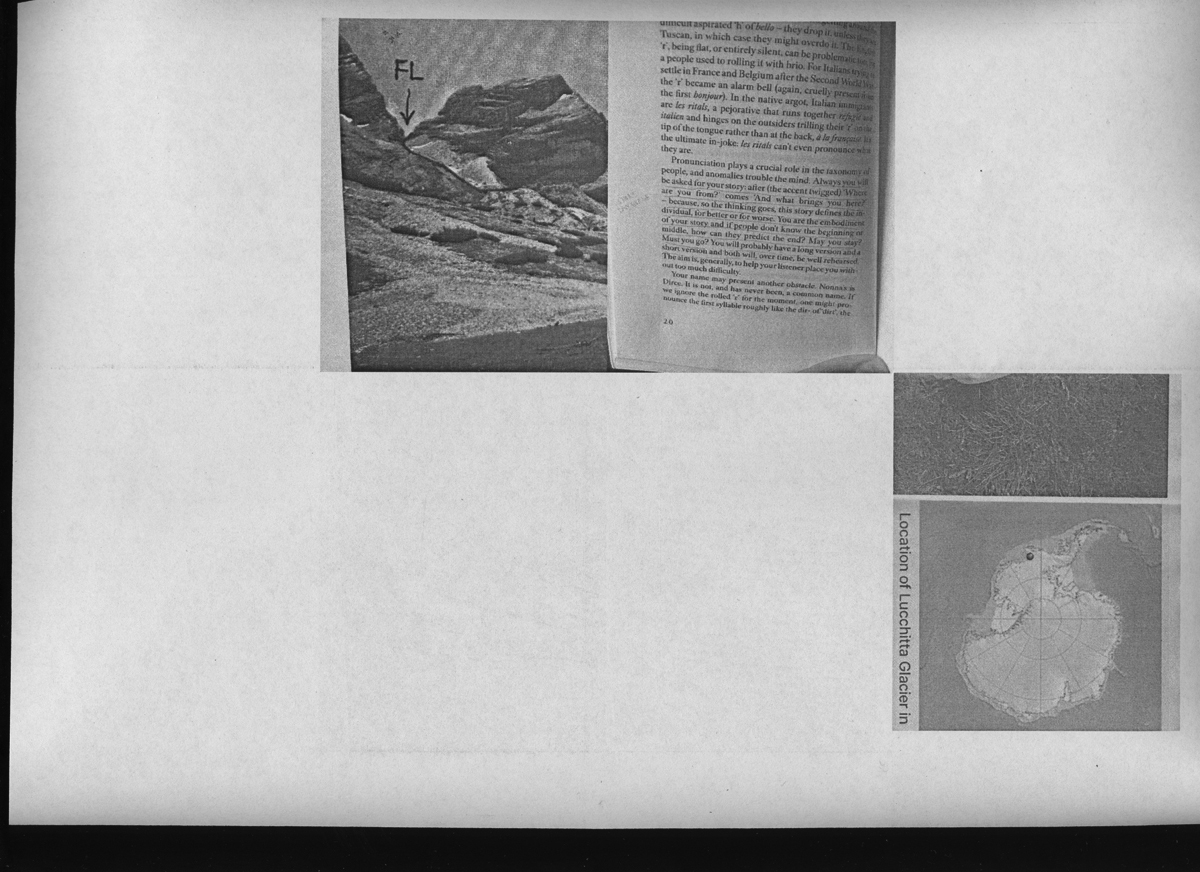
15/09/23
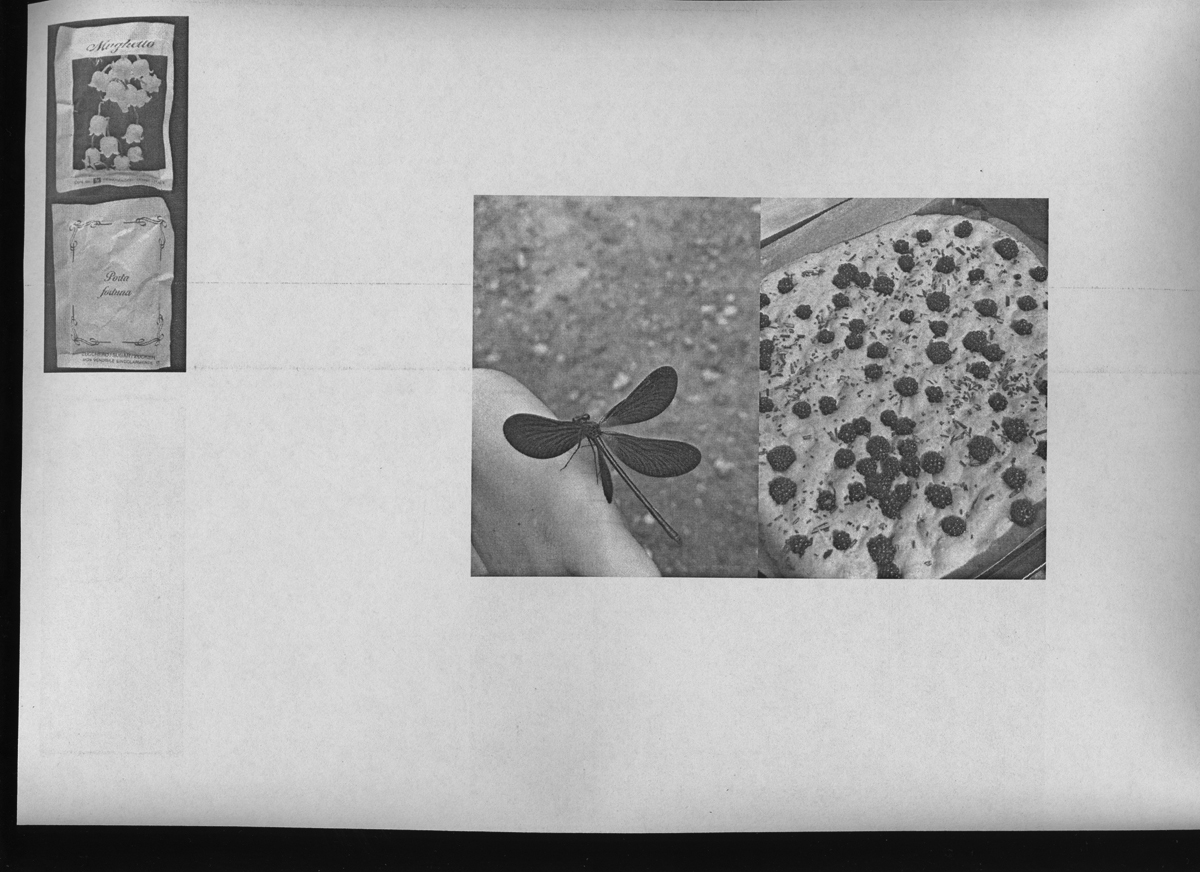
10/09/23
_Fabric
The brambles are full of blackberries. Some ripe and dark blue-violet to be picked up, others still sour and tending to red colour. It is nice to collect them slowly, some for everyday, until the last ones are ripe.
We walked down and slowly filled our hands with these bubbly sweet berries, then Vida curved up the bottom edge of her shirt and we all started to put them in this soft container. Along the path we found some little lilac flowers too – tasting fresh like mint. We picked some, put them together with the blackberries and carried everything up at home for dinner with the others.
Some time ago while walking down the terraces of Topolò, I found the hood of my jacket filled with flowers and leaves from the forest. Kim and many others delicately put elements encountered along the path. I discovered it was filled with all these traces only once it started to rain and I had to wear the hood. I moved everything into my pockets and carried it with me.
Another time, when living in Switzerland, during one of my daily walks in Appenzeller I suddenly encountered a bakery still using a wood oven to cook bread. The bakery was a little space filled with delicious pastries, breads and a few other local products. Lucky enough I had some Swiss francs in my pocket and after buying some bread I put it in my hood and carried it till St.Anton. Then the hood was empty again to be used in the coming days during other walks to carry books or some groceries from Oberegg, Trogen or Heiden up to St.Anton.
Clothes carry traces of experiences, some permanent marks, some little cuts, some temporary stains. I have a certain fascination for the care that most of the time I have towards these garments, trying to fix them, to clean them, to make them look as ‘at the beginning’ – when I got them, to keep them in time. Other times I find myself happily surprised to be reminded of certain moments and stories by these traces on the fabric around me.
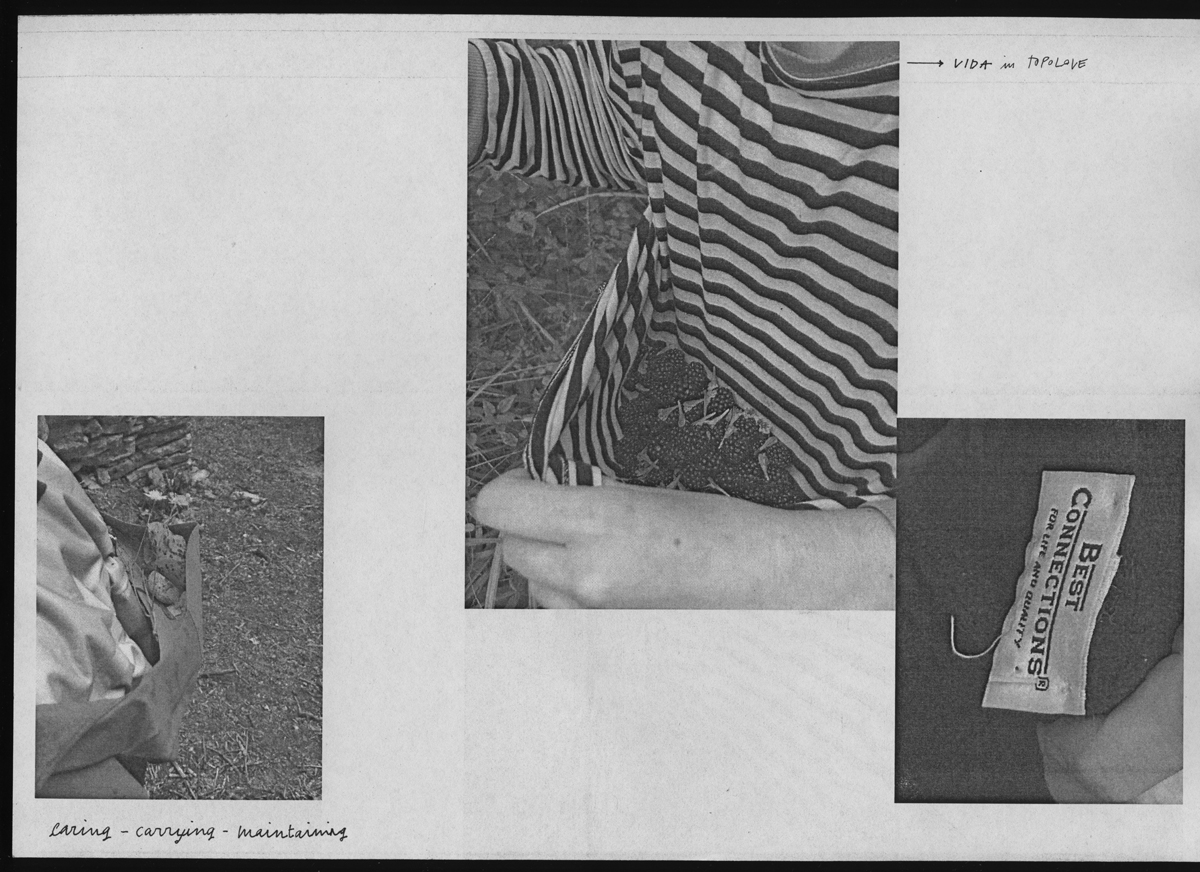
07/07/23
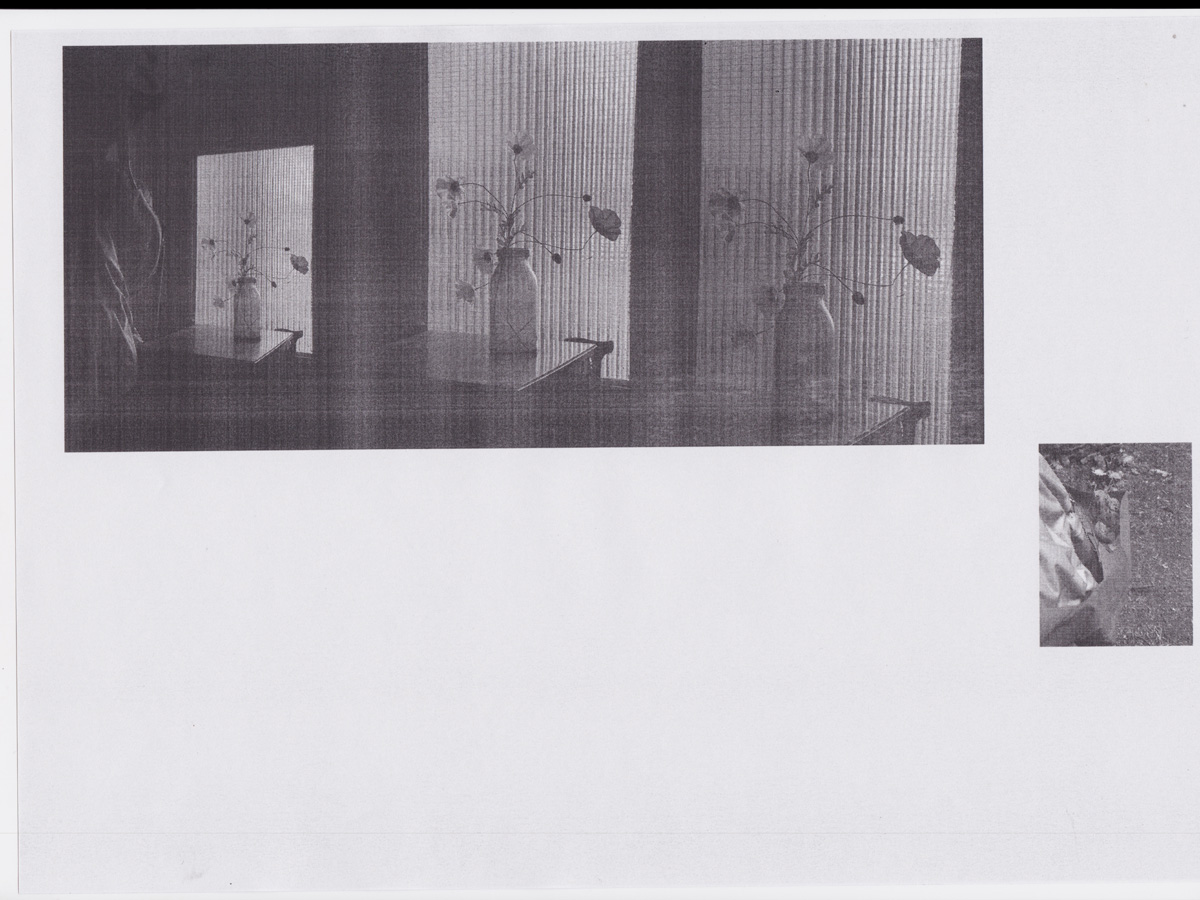
16/06/23
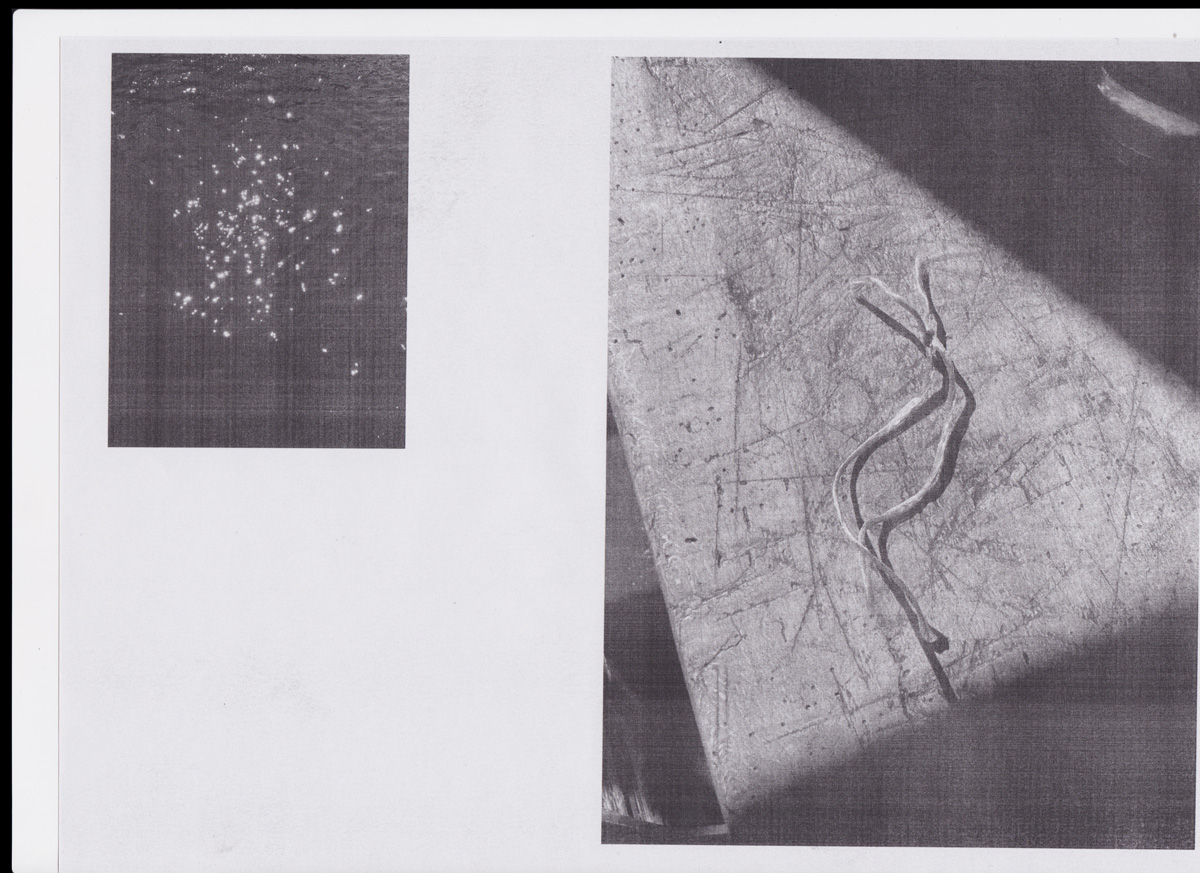
27/05/23
_Gestures of Care
Wild garlic leaves were already there, in a big white box in the fridge for days. Dora, Laura and Ola harvested them in the forest, and now they needed some care. I sat in the sun on the muretto – a little wall lower than a meter – in front of me the big white box with leaves, on the side a red colander for the ruined leaves and a white bowl to put the good ones for Elena making pesto in the kitchen.
I was trying to be fast and to sort out the box before the beginning of the lunch when Riko, a beekeeper from Slovenia, came closer and calmly started a conversation around wild garlic. He eats the leaves in salad, with olive oil, salt and pepper and sometimes he eats the bulbs too after preparing them as pickles.
I went inside for a moment and once back outside I found Riko sitting on the muretto and taking care of the wild garlic leaves. I sat on the ground next to him and for a moment I just silently observed the gestures of his hands delicately taking one or two leaves at a time and carefully opening their curled edges to finally place them in the white bowl. By looking at him my rhythm also changed and my attention and care too.
23/03/23
_pp. 108-109
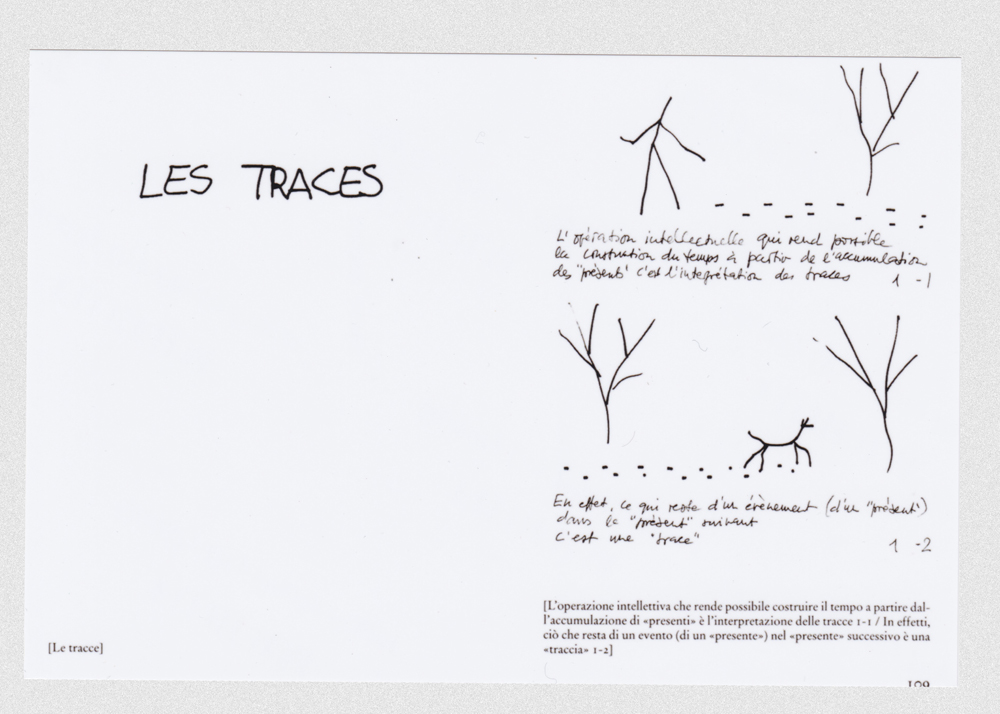
20/03/23
_Line
For movement’s sake the line is free to go where it will and in reading it, the eyes follow the same path as did the hand in drawing it.
Drawing a line is much like telling a story, the storyline goes along as does the line. The line is a path traced through the terrain of lived experience. To tell a story, Ingold says: “is to relate, in narrative, the occurrences of the past, retracing a path through the world that others, recursively picking up the threads of past lives, can follow in the process of spinning out their own”.
We spent days following lines imagined by someone years ago, maybe many years ago. First traced by the eyes on the rock, then performed with body movements and finally traced by a pen on a map. The drawing allows the line to be repeated, thus, the body gestures to happen over and over, again and again. Every repetition, slowly, in time, creates the story of that line on the rock. Every movement embodies the desire to experience that specific story on the limestone, granite, conglomerate. Once the line finishes, another one attracts the attention. One line follows the other. Lines connected through the landscape. Stories connected through people's experience.
“There is always somewhere further to go. And in storytelling as in wayfaring, it is in the movement from place to place – or from topic to topic – that knowledge is integrated.”
*Tim Ingold, Lines: Up, Across and Along, Routledge, 2007
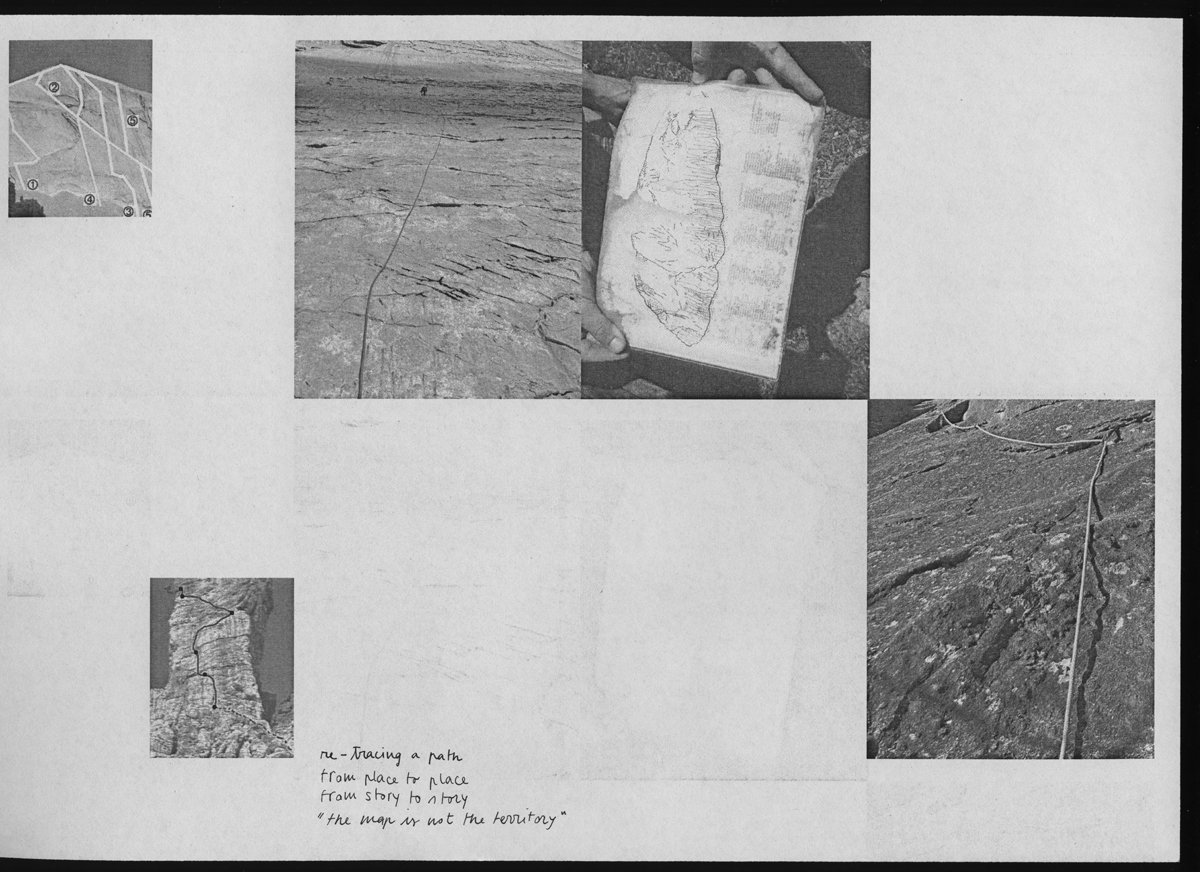
08/02/23
_Tingling
When the sunlight touches the surface of the water little sparkles appear – I call them tingles. It somehow makes me smile and feel light. When tingles affect my body, I usually can't calm down, a special enthusiasm takes over everything and makes me feel bubbling.
I love the Italian word to define this phenomena: 'formicolio', from 'formica' (ant); as when I was young and without noticing I sat over an ant hill – multitude in motion – and suddenly my body was covered of these fast little insects.
I experience different types of this little slight prickling sensation. Tingling describes both the quick, very quick movement of elements in space, the strong feeling of an emotion, and the feeling as if a lot of sharp points are being put quickly and lightly into the body.
Tingles for the unknown. Tingles for surprises. Tingles for excitement. Tingles of fear. Pins and needles.
Sometimes I take a moment to observe the splendid sparkles flowing on the surface of the water creating an over-shifting brilliant pattern. Somehow standing in a point and observing this spectacle gives me a sense of, at the same time, calm and excitement. Their magic and ephemeral presence is hard to grasp and even when I see them, if I slowly move I notice how the sparkle slowly disappears, but I carry some tingles with me.
I clearly remember when two years ago I started to feel it again. It was the beginning of spring, days were getting longer here in the lowlands and after a slow and introspective period I suddenly started to feel better. The sunlight reflected in the canals of Amsterdam made me smile and a sensation of lightness swept all over me. The months after I just felt constant tingles for the present and the unknown, a lot of energy and desire to explore, share with others and let myself be surprised again. Many other tingling moments followed. Sometimes they are little situations–traces–memories that I like to remember and carry-with-me. Lived moments, that if I think about, I immediately feel some joy.
“How else do most of us experience history if not in the presence or absence of small things?”
Thea Lenarduzzi, Dandelions, Fitzcarraldo, 2020
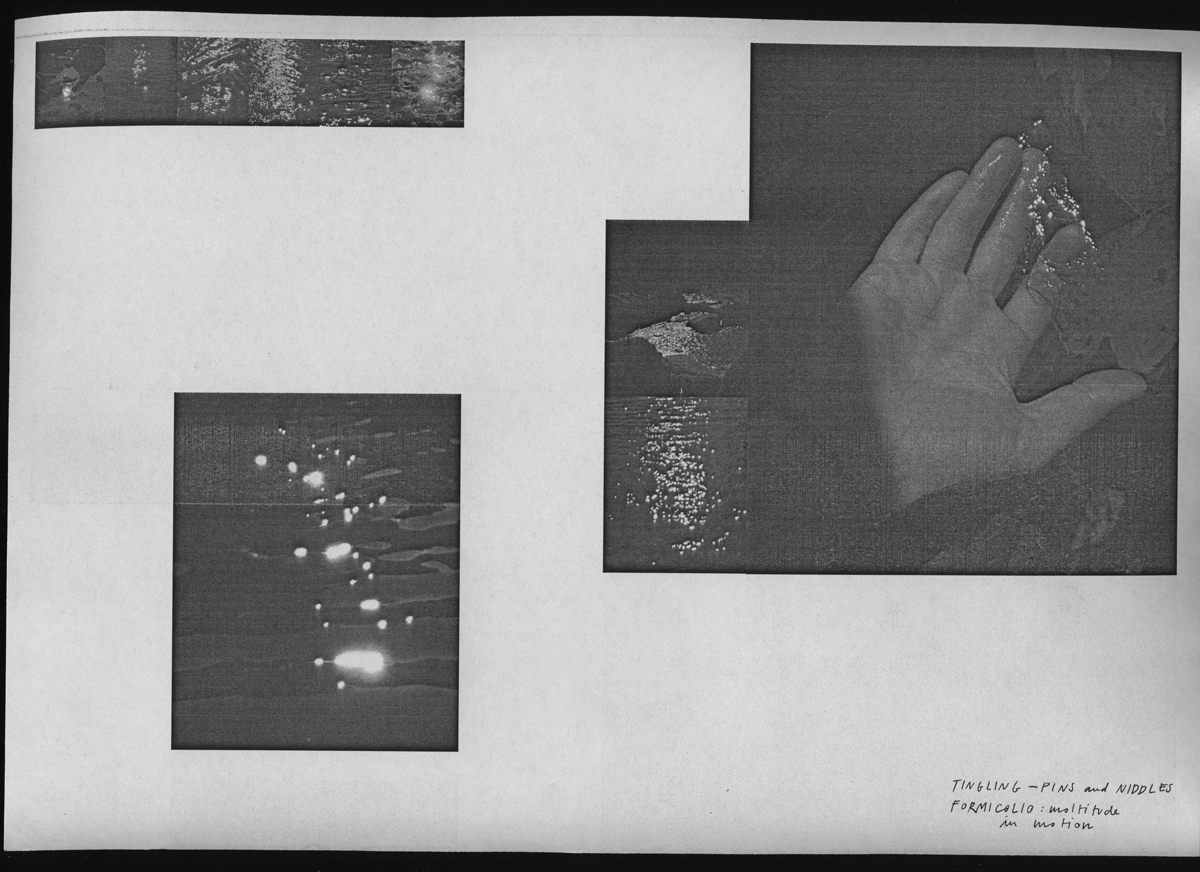
24/05/22
_Coucou
Where does this ‘coucou’ come from?
It was the end of a summer day and I was hiking with Elena on the ‘Sentiero delle Portatrici Carniche‘ (the path of the Carnic Barer – women that during the WWI were bringing food to the soldiers at the war front) at the border between Italy and Austria. Our day of walking had started far away at Tolazzi shelter, on the other side of the valley we coudn't see anymore. With a bright soft last ray of light from the sunset illuminating some of the peaks in front of us we left Casera Palgrande di Sopra. The atmosphere all around was getting misty with shades of pink dissolving into lilac, light blue and slowly blue, and our paste was fast, with firm steps, no hesitation and wheezing breath.
While walking up the last mountain side it was getting darker and darker. Once we reached the mountain ridge we were suddenly at the same time looking at two different realities: on one side the far away sunset and ridged upon ridges of mountains appearing in shades of blue (*Rebecca Solnit, The Blue of Distance), on the other side, for a moment, a few seconds, we could barely see the shape of the Avostanis Lake reflecting the last light in the sky. Then everything turned dark, deep dark and we couldn’t see anything anymore. It was only us and the conoidal small shape of light coming from the torches on our heads.
The rhythm of our movements immediately changed – we started to walk slowly and somehow softly. All around us was just deep black – how does deep black look like?
When we saw the little light coming from the shelter close to the lake we impulsively started to scream “coucou” – “coucouuuuu”. In a few seconds, we got a “coucou” back and saw a light coming out of the little building. Goosebumps. After many attempts to find the path, many walking forward and backwards, we could start the descent and reach our friends at Malga Pramosio Alta.
